JKBOSE 10th Class Science Solutions Chapter 11 Life Processes
JKBOSE 10th Class Science Solutions Chapter 11 Life Processes
JKBOSE 10th Class Science Solutions Chapter 11 Life Processes
Jammu & Kashmir State Board JKBOSE 10th Class Science Solutions
J&K class 10th Science Life Processes Textbook Questions and Answers
BASIS AND BASICS
◆ Visible movement is not the only defining characteristic of life.
◆ Plants do not show locomotory movements, but movements occur at molecular level. Viruses are living only inside living organisms.
◆ Every living organism takes food, derives energy, passes out waste material and responds to changes within body and environment. All these activities are collectively termed as life processes.
◆ These life processes are required for maintenance of life.
◆ Criteria used to decide whether something is alive
Following are the standards that decide whether something is alive :
1. The major criterion which is used to decide whether something is alive is movement. Movement may be incurred through locomotion (walking), action, of body parts (chewing by cow), growth (in plants), maintenance and repair of cellular structures and molecular movement in metabolic reactions.
2. The ability to sense the surroundings and show proper response is one of the basic properties of living organisms. Plants, animals and even microorganisms can sense the changes in environment and show responses. Consciousness therefore, becomes the defining property of living organisms.
3. The living organisms have definite life span.
4. The requirement of food to get energy for performing life activities.
5. Living organisms show respiration and utilization of the inhaled oxygen for oxidation of food.
6. The expulsion of metabolic wastes (Excretion).
7. The multicellular organisms show cellular organization of the body. Each living cell is highly organized.
◆ Body needs energy which is obtained from the food that organism eats.
◆ Food or nutrients provide energy, materials for growth, maintenance and reproduction.
◆ The process of obtaining, digestion, absorption, distribution and utilization of food is called nutrition.
◆ Mode of nutrition may be autotrophic or heterotrophic.
◆ Autotrophic mode of nutrition. The energy is directly used for synthesis of organic food molecules from inorganic substances. It is called autotrophic mode of nutrition.
◆ Autotrophs. (Auto-self; troph-nutrition) The organisms which prepare their own food are called autotrophs.
◆ Heterotrophic (Hetero-different; troph-nutrition). The mode of taking readymade organic food materials. It may be holozoic, saprophytic and parasitic.
◆ Respiration is the process in which food is oxidised to release energy. Respiration can be aerobic or anaerobic. The first step in respiration is called breathing.
◆ Transport of materials. Animals have evolved different organs for the uptake of oxygen from the surroundings and for release of carbon dioxide.
◆ In human beings, the transport of materials like oxygen, carbon dioxide, food and excretory products is a function of the circulatory system. The circulatory system consists of heart, blood and blood vessels.
◆ In higher plants, transport of water, minerals, food and other materials is a function of the vascular tissue which consists of conducting tissues, xylem and phloem.
◆ Excretion. All plants and animals produce harmful substances due to a number of metabolic activities occurring in their body tissues. These harmful substances are to be eliminated from the body, otherwise they act as toxic substances.
◆ In human beings, excretory products in the form of soluble nitrogen compounds are removed by the nephrons in the kidneys. Plants use a variety of techniques to get rid of waste materials which are stored in the cell vacuoles, like removing them in the falling leaves or excreted into the surrounding soil.
IMPORTANT TERMS AND FACTS TO MEMORISE
⇒ Saprophytes. The organisms which depend on dead, decaying organic matter for their nutritional requirements are called saprophytes.
⇒ Parasites. Those organisms which depend upon other organisms for their food and shelter are called as parasites. There are two types of parasites i.e. ectoparasites and endoparasites.
⇒ Holozoon. Holozoons are heterotrophs which involve intake of solid pieces of food. Since solid food is taken in, holozoic nutrition is also called ingestive nutrition. It is found in animals and Protozoa.
⇒ Herbivorous. The organisms which take their food in the form of plants and plant products are called herbivorous.
⇒ Carnivorous. Those organisms which rely on the flesh of other organisms are called carnivorous.
⇒ Omnivorous. Those organisms which can feed upon plants as well as other organisms are called omnivorous.
⇒ Ingestion. The process of intake of food in the mouth is called ingestion.
⇒ Digestion. The process of breakdown of material into simpler substances is called digestion.
⇒ Egestion. It is the process of removal of undigested and unabsorbed food from the body.
⇒ Photosynthesis. The autotrophs take in CO₂ and H₂O and convert these into carbohydrates in the presence of chlorophyll and sunlight is called Photosynthesis.
⇒ Compensation point. In the shadow (morning and evening) when photosynthesis obis very low, the CO₂ produced in respiration is equal to the CO₂ consumed in photosynthesis. This situation when the CO₂ absorption from environment is about nil is called as compensation point.
TEXT BOOK QUESTIONS (SOLVED)
Q. 1. Why is diffusion insufficient to meet the energy requirements of multicellular organisms like humans?
Ans. In multicellular organisms, all the cells of body may not be in direct contact with the surrounding source of oxygen i.e. environment, thus simple diffusion will not meet the oxygen requirements of all the cells. These organisms require specialised organs to meet the oxygen requirement.
Q. 2. What criteria do we use to decide whether something is alive?
Ans. Features of living organisms
1, Movements
2. Growth
3. Metabolism
4. Cellular body
5. Nutrition
6. Respiration
7. Transportation
8. Excretion
9. Respond to stimuli
10. Reproduction.
Q. 3. What are outside raw materials used by living organism ?
Ans. Outside raw materials used by living organism
1. Food. It is the source of energy.
2. Oxygen. Required for breaking down of carbon based molecules to liberate energy in the body.
3. Water. It is required for proper digestion of food and other functions in the body. It is raw material for photosynthesis in plants.
4. CO₂. Raw material for photosynthesis in plants.
Q. 4. What processes would you consider essential for maintaining life ?
Ans. 1. Nutrition 2. Respiration 3. Transportation 4. Excretion.
Q. 5. What are the differences between autotrophic and heterotrophic nutrition ?
Ans. Differences between Autotrophic and Heterotrophic nutrition
| Autotrophic Nutrition | Heterotrophic Nutrition |
|
1. It occurs in green plants and blue- green algae.
2. CO₂ and water are raw materials which combine to form organic compound.
3. They need chlorophyll and sunlight.
|
1. It occurs in animals and insectivorous plants.
2. They depend on plants and herbivores for their food.
3. There is no need of chlorophyll and sunlight.
|
Q. 6. Where do the plants get each of raw materials required for photosynthesis ?
Ans. Raw materials of photosynthesis
1. CO₂
2. Water
3. Sunlight.
1. CO₂ is obtained from air. It enters the leaf through stomatal openings.
2. water is obtained from soil. It enters the leaf through mid-rib and vein from the root which absorbs it from the soil.
3. Sunlight. It is trapped by a group of chlorophyll molecules present in the chloroplast of green leaves.
4. Chlorophyll. Acts as a trapping centre present in chloroplast.
Q. 7. What is the role of acid in our stomach ?
Ans. Functions of HCI
(i) It provides acidic medium. It is required for the action of enzymes. It changes the pH of food from almost neutral to acidic medium (from pH 7 to 2).
(ii) Activates the proenzyme propepsin into active pepsin.
(iii) Kills the bacteria present in food.
Q. 8. What is the function of digestive enzymes ?
Ans. Role of digestive enzymes. These enzymes convert the non-diffusible form of food into diffusible form.
1. Ptyalin converts starch into maltose.
2. Pepsin breaks down proteins into peptides and amino acids.
3. Lipase acts on fats and forms fatty acid and glycerol.
4. Maltase acts on maltose and forms glucose.
Q. 9. How is small intestine designed to absorb digested food ?
Ans. Small intestine is a long tubular structure. The inner wall of small intestine is thrown into folds called villi. The absorptive cells have numerous finger-like processes called microvilli. They increase the surface area for absorption of food.
Q. 10. What advantage over an aquatic organism does a terrestrial organism have with regard to obtaining oxygen for respiration ?
Ans. The amount of oxygen dissolved in water is very low as compared to the amount of oxygen in air. Thus, these organisms have to make less efforts to obtain oxygen.
Q. 11. What are the different ways in which glucose is oxidised to provide energy in various organisms ?
Ans. Different pathways to provide energy from glucose
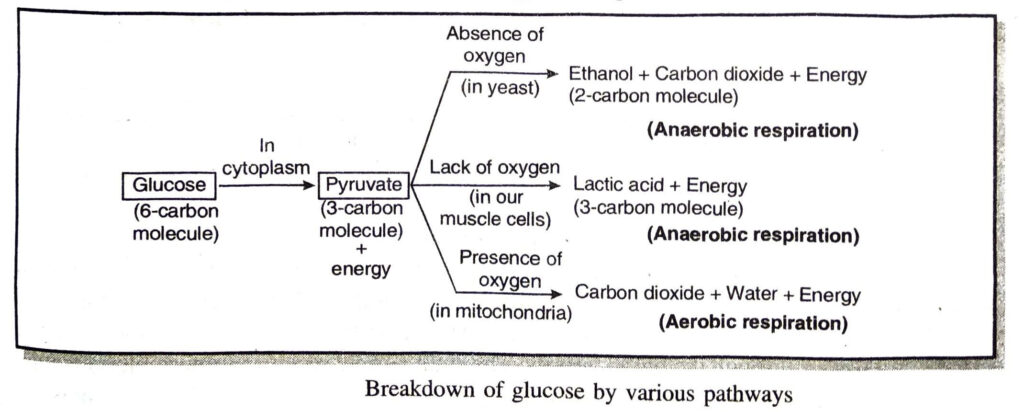
Q. 12. How is oxygen and CO₂ transported in human beings ?
Ans. 1. Transport of oxygen. It is transported from respiratory organs to body cells. (i) Haemoglobin helps in the transport of oxygen. In the alveoli of the lungs, the hemoglobin (Hb) present in red blood corpuscles combines with oxygen to form oxyhemoglobin. When the blood reaches the tissue, oxygen is released from the oxyhaemoglobin for the consumption by the tissues.
Hb+ O₂ → HbO₂
(ii) Some of O₂ is transported in the solution form by plasma of blood.
2. Transport of CO₂
1. CO₂ diffuses into blood plasma to form physical solution.
2. CO₂ forms unstable carbonic acid with water and is transported as such.
3. CO₂ is also transported from tissue to lungs as bicarbonates.
Q. 13. How are lungs designed in human beings to maximise the area for exchange of gases ?
Ans. Within the lungs, the primary bronchi divides into smaller and smaller tubes which finally terminate into balloon-like structures called alveoli. These alveoli increase the surface area for exchange of gases. There are 750 million alveoli in the lungs of man. If the alveolar surface is spread out it would cover about 80 m². Thus it makes efficient exchange of gases. Each alveolus or air sac has a diameter of 75 to 300 microns and has a very thin wall. The walls of the alveoli are elastic and are supplied with capillaries. Through these thin walls gases are exchanged between the capillaries and the air sacs.
Q. 14. What are the components of transport system in human beings ? What are function of these components ?
Ans. There are two main transport systems in human beings :
1. Blood vascular system.
2. Lymphatic system.
Components of blood vascular system
1. Blood. It is a reddish viscous fluid connective tissue. In an adult human being, it is 5-6 litres in amount. Blood consists of two parts – plasma and formed elements.
Formed elements are:
(a) RBCs (Erythrocytes) carry oxygen.
(b) WBCs act as soldiers and protect the body from attack of foreign particles/organisms.
(c) Blood platelets. Play important role in clotting of blood in case of injury.
Function. Blood transports digested food, oxygen, carbon dioxide, nitrogenous wastes and hormones in the body.
2. Heart. It is a hollow, muscular pumping organ.
The heart, in fact, has four water tight chambers, the receiving chambers called auricles or atria and the distributing chambers ventricles. The left auricle receives purified blood from the lungs and empties into left ventricle. The left ventricle distributes blood to various organs and tissues through the blood vessels. The right auricle receives impure blood from all parts of body and empties it into the right ventricle. The later sends the blood to lungs.
Function. Heart is a pumping organ. Heart pumps the blood in the body.
3. Blood vessels
1. Arteries. Carry oxygenated blood to body parts.
2. They divide to form capillaries of finer dimensions. Exchange of materials takes place across the capillaries. It is possible because the walls of capillaries are extremely thin.
3. Veins collect and transport deoxygenated blood from body parts.
Components of lymphatic system
1. Lymph
2. Lymph vessels
3. Lymph capillaries
4. Lymph nodes
Q. 15. Why is it necessary to separate the oxygenated and deoxygenated blood in mammals and birds ?
Ans. 1. In the heart of these organisms the left side has oxygenated blood and right side deoxygenated blood.
2. The separation of blood allows a highly efficient supply of oxygen to the body.
3. It is essential for such animals which have high energy needs.
4. They also constantly use energy for maintaining body heat.
Q. 16. What are the components of transport system in highly organised plants?
Ans. Components of transport system in plants
1. Xylem tissue. Vessels and tracheids of roots, stems and leaves are concerned with transport of water and minerals.
2. Phloem consists of sieve tubes and companion cells. It transports food, amino acid and other substances from leaves to various parts of plants.
Q. 17. How are water and minerals transported in plants ?
Ans. Transport of water and minerals
1. In xylem tissue, vessels and tracheids of the roots, stems and leaves are interconnected to form a continuous system of water conducting channels reaching all parts of the plants.
2. Plants absorb water and minerals through their entire surface i.e., roots, stem and leaves. However, mainly the water is absorbed by roots.
3. The area of young roots where most of the absorption takes place is the root hair zone.
4. This zone is the area of greatest permeability.
5. Passage of water in root or pathway of water in root
(a) The entry of water into the root hair dilutes the cell sap. Thus water molecules in root hair increase as compared to adjacent cortical cells.
(b) Water reaches the passage cells of endodermis. These passage cells lie opposite the xylem.
(c) They allow water to enter the pericycle.
(d) So, water enters the xylem from pericycle for upward movement of sap.
6. The Ascent of Sap
The upward movement of water from the root towards the top of the plant in the xylem vessels is called ascent of sap. The upward transport of water and minerals in plants which are in some cases as tall as 400 ft. poses a serious problem.
7. Transpiration also helps in the absorption and upward movement of water and minerals dissolved in it from roots to the leaves.
Q. 18. How is food transported in plants ?
Ans. Transport of food in plants
The food prepared in the green leaves of plants is transported through phloem in the form of sucrose solution to storage organs of roots, seeds and fruits. This process called translocation. This process requires energy. The phloem is living tissue. Sieve tube cells of phloem help in movement of food. These cells are elongated and placed end to end. The energy is provided by ATP molecules. This increases the osmotic pressure in the tissue causing water to move into it. This pressure moves the material in the phloem to tissues which have less pressure.
Q. 19. Describe the structure and functioning of nephron.
Ans. Structure of a Nephron
A nephron is made up of
(i) a globular double walled Bowman’s capsule around a clump of capillaries or glomerulus, and
(ii) a tubule surrounded by blood capillaries. The tubule consists of (a) a proximal convoluted portion, (b) the loop of Henle, with descending and ascending limbs, and (c) a distal convoluted part.
The nephron empties into a collecting duct. The two million nephrons of a human being, end to end would extend for nearly 80 km. All the collecting ducts discharge into a central cavity of the kidney (pelvis) that connects to the ureter.
Functioning of Nephron
Urine is formed by 3 processes: glomerular filtration, tubular reabsorption and tubular secretion in the nephrons of kidney.
1. Ultrafiltration (Glomerular filtration)
Blood is filtered under pressure in the glomeruli present in the cup-like structure of Bowman’s capsule. Glomerular (nephric) filtrate is formed.
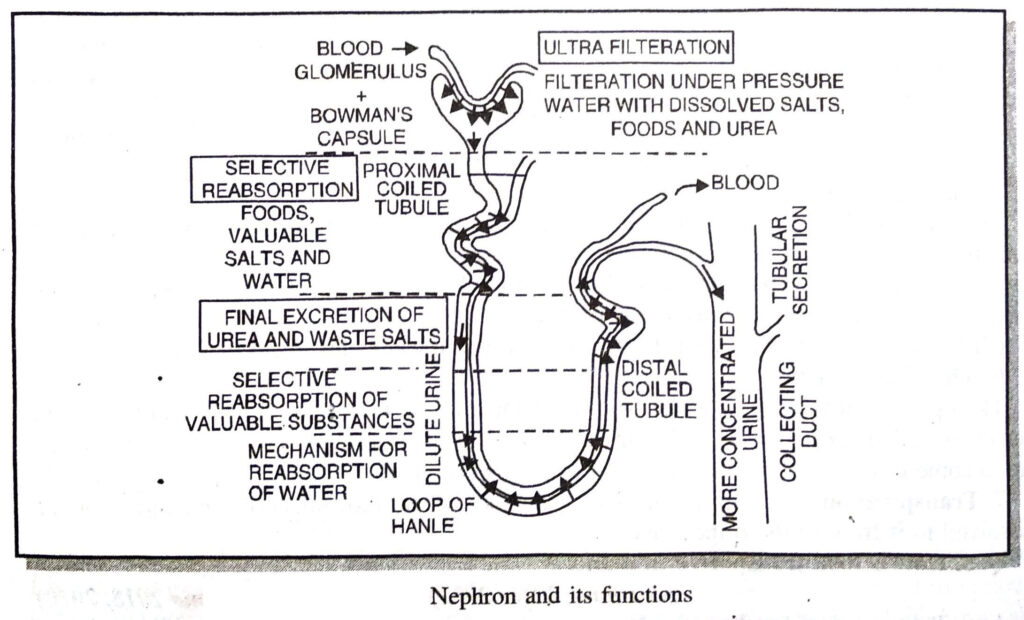
2. Tubular reabsorption
In the PCT, entire glucose, amino acids, vitamins and hormones, most of the inorganic ions are reabsorbed by active transport, most of water by osmosis, and some urea by back diffusion from nephric filtrate.
Loop of Henle mainly concentrates urine to conserve water. Here, some inorganic ions are actively taken up and some water leaves by osmosis.
3. Tubular secretion
In the DCT, collecting tubule and collecting duct, many ions, water (depending upon availability) are secreted in to DCT and collecting duct.
Urine formed passes into bladder from kidney through ureters.
Q. 20. What are the methods used by plants to get rid of excretory products?
Ans. Excretion in Plants
1. Excess of water passes out during transpiration.
2. Plants get rid of dead tissue as a measure to eliminate waste.
3. Waste products may be stored in cellular vacuoles.
4. Waste products may be stored in leaves which fall off.
5. Resins and gums are stored in old xylem.
6. Plants also excrete wastes into soil.
7. Aquatic plants lose their waste products by diffusion into the water.
Q. 21. How is the amount of urine produced regulated ?
Ans. 1. Amount of urine formed depends upon the availability of water in the body.
2. Amount of water reabsorbed depends on how much excess water is there in the body and how much of dissolved waste is to be excreted out.
3. ADH (Antidiuretic Hormone) regulate the amount of water.
4. Osmoregulation helps in regulation of salts and water.
5. Urine is stored in urinary bladder.
TBE TEXT BOOK EXERCISES (SOLVED)
Q. 1. The kidneys in human beings are a part of the system for :
(a) nutrition
(b) respiration
(c) excretion
(d) transportation.
Ans. (c) excretion.
Q. 2. Select the correct answer
The xylem in plants are responsible for :
(a) transport of water.
(b) transport of food.
(c) transport of amino acids.
(d) transport of oxygen.
Ans. (a) transport of water.
Q. 3. The autotrophic mode of nutrition requires :
(a) CO₂ and water
(b) Chlorophyll
(c) Sunlight
(d) All of above.
Ans. (d) All of above.
Q. 4. Select the correct answer :
The breakdown of pyruvate to give CO₂. water and energy takes place in :
(a) cytoplasm
(b) mitochondria
(c) chloroplast
(d) nucleus
Ans. (b) mitochondria.
Q. 5. How are fats digested in our bodies? Where does the process take place ?
Ans. Digestion of fats takes place in the intestine. Fats are present as large globules. Bile salts break them down into small globules to increase the efficiency of fat digesting enzymes. The fats are emulsified by the bile salts present in bile. The emulsified fats are acted upon by pancreatic lipase (strepsin) which hydrolyses fats into fatty acids and glycerol. The intestinal lipase also hydrolyses the emulsified fats into fatty acids and glycerol.

Q. 6. What is the role of saliva in the digestion of food ?
Ans. Role of saliva
1. Saliva lubricates the food and facilitates mastication.
2. Saliva binds the food molecules together.
3. Saliva contains ptyalin (salivary amylase) enzyme which acts on starch, glycogen and other carbohydrates to form maltose.
Q. 7. What are the necessary conditions for autotrophic nutrition and what are its byproducts ?
Ans. Conditions required for photosynthesis
1. CO₂ is necessary for photosynthesis.
2. Water is required.
3. Sunlight is necessary for photosynthesis.
4. Chlorophyll is essential for photosynthesis.
By-products. Molecular oxygen is liberated as a byproduct.
Q. 8. What are the differences between aerobic respiration and anaerobic respiration ? Name some organisms that use anaerobic mode of respiration.
Ans. (a) Differences between aerobic and anaerobic respiration
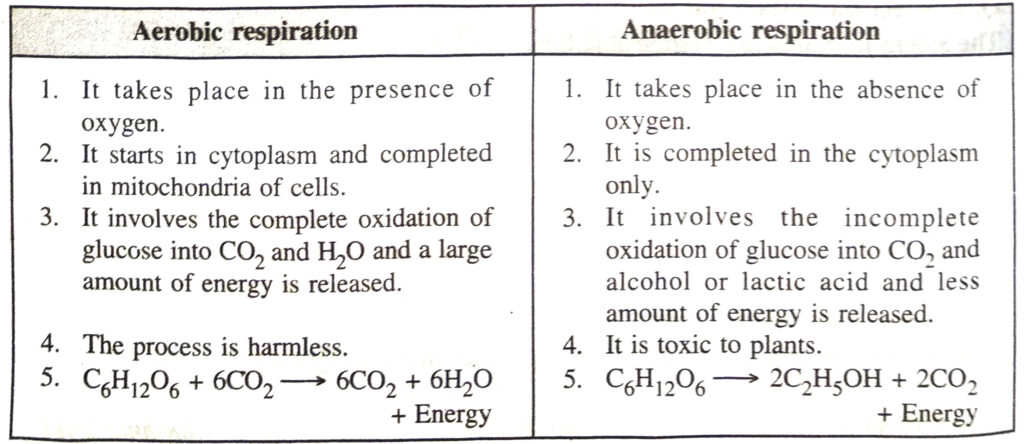
(b) Anaerobic respiration takes place in bacteria, yeast and muscle cells.
Q. 9. How are alveoli designed to maximise the exchange of gases ?
Ans. Air tubes (passages) which reach lungs divide and redivide and finally terminate into SOLITA balloon like structure called alveoli. The thin walls of alveoli are richly supplied with blood. Thus alveoli provide large surface area for exchange of gases.
Q. 10. What would be the consequences of a deficiency of haemoglobin in our bodies ?
Ans. Haemoglobin is a respiratory pigment present in RBC of blood. It has high affinity for oxygen. If haemoglobin content reduces in the blood, the oxygen carrying capacity decreases. The deficiency of haemoglobin cause anaemia, breathlessness, tiredness and pale skin etc. are symptoms of anaemia.
Q. 11. Describe double circulation in human beings. Why is it necessary in human beings ?
Ans. Double circulation. The blood passes twice through the heart to complete circulation. In human beings heart is four-chambered, having right and left auricles and right and left ventricles.
Pulmonary Circulation. The right auricle receives the deoxygenated blood from the body and sends it into the right ventricle that pumps it to the lungs via a pulmonary arch for oxygenation. The left auricle receives oxygenated blood from the lungs.
Systemic circulation. The left auricle sends oxygenated blood into the left ventricle, which pumps it to the body through a single aortic arch. The deoxygenated blood is returned to heart by superior and inferior venacavae after collecting by numerous veins from body organs.
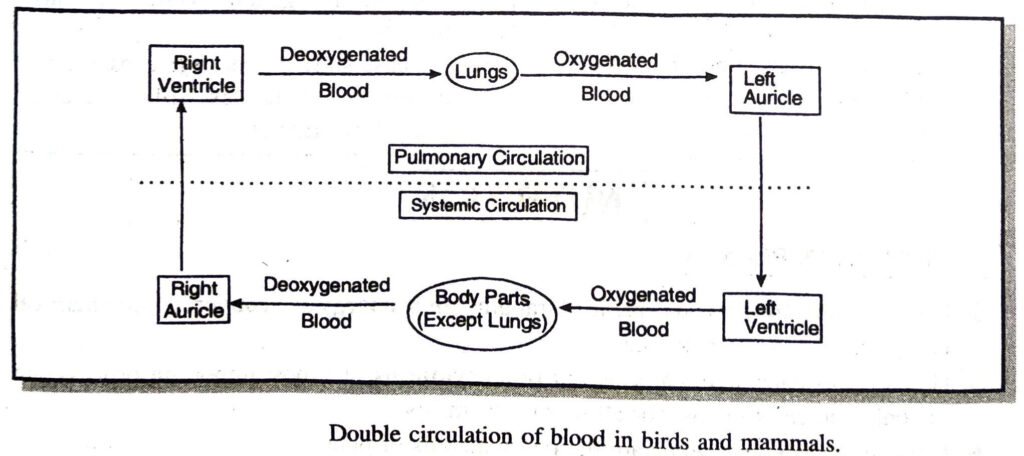
Significance. 1. Thus, the deoxygenated and oxygenated blood remain fully separate and there is complete double circulation.
2. It increases efficiency.
Q. 12. What are the differences between the transport of materials in xylem and phloem ?
Ans. Differences between transport in xylem and phloem
| Transport in xylem | Transport in phloeme |
|
1. Water and minerals are transported through xylem.
2. Xylem helps in upward movement, i.e. from roots to stem, branches and leaves.
3. Movement is achieved simply by physical force.
|
1. Sucrose, amino acids and other substances are transported through phloem
2. Phloem is responsible for downward and lateral movement from leaves to other parts.
3. Movement of food is active process and requires energy.
|
Q. 13. Compare the functioning of alveoli in the lungs and nephrons in the kidneys with respect to their structure and functioning.
Ans. Comparison of functioning of alveoli of lungs and nephrons in the kidney
| Alveoli of lungs | Nephrons in the kidneys |
|
1. These are balloon like structures within the lung.
2. Thin walls of alveoli contain extensive network of blood vessels.
3. Play vital role in exchange of gases.
4. Increase surface area for exchange of gases.
|
1. These are long, coiled tubule-like structures present within the kidneys.
2. Nephrons contain a bundle of blood capillaries called glomerulus. The tubular part is also surrounded by blood capillaries
3. Separate nitrogenous waste materials from blood.
4. Increase surface area for reabsorption of useful substances, filtration and water form filtrate.
|
ADDITIONAL IMPORTANT QUESTIONS
LONG ANSWER TYPE QUESTIONS
Q. 1. What is nutrition ? Briefly explain the two major kinds of nutrition.
Or
Define autotrophic nutrition.
Ans. Nutrition. All living organisms need matter to build up the body and energy to operate the metabolic reaction that sustains life. The materials which provide these two primary requirements of life are called nutrients or foods. The sum total of processes by which organisms obtain matter and energy is termed nutrition.
Modes of Nutrition
The organisms have evolved two different modes of nutrition :
1. Autotrophic or Holophytic nutrition. All green plants and certain protozoans (Euglena) have evolved a mechanism to directly use the energy of sunlight for preparing organic food in their own body from simple raw materials i.e. CO₂ and H₂O. These simple inorganic materials are transformed into glucose and oxygen is evolved.

2. Heterotrophic Nutrition. Animal, fungi, (Amoeba) and many bacteria cannot utilize solar energy. They use chemical bond-energy of organic molecules synthesized by other organisms in building their own organic molecules. Such a mode of feeding is termed as heterotrophic nutrition, and the organisms having it are called heterotrophs.
Q. 2. Explain the two main steps of photosynthesis.
Ans. Photosynthesis occurs in two main steps. 1. The first step is dependent upon light and the second step is not dependent upon light. Hence, the former is called light reaction or photochemical phase while the latter, the dark reaction or biosynthetic phase of photosynthesis.
2. Water is split up during photosynthesis by the process called photolysis. It provides reductant for carbon dioxide. Oxygen is liberated. All the liberated oxygen, therefore, comes from water.
3. The photolysis of water in photosynthesis was discovered by Hill known as Hill reaction.
4. The light reaction of photosynthesis is followed by the dark reaction. In this, CO₂ is first fixed by ribulose diphosphate and from this fixed CO₂ phosphoglyceric acid is formed. The phosphoglyceric acid thus formed ultimately forms carbohydrates.
5. The basic organic compound formed in photosynthesis is often considered to be glucose. enoiton lativ zuoney The storage product of plants is commonly starch.
6. A chemical equation of photosynthesis is

7. In plants and most algae it occurs in the chloroplasts i.e., light reaction and dark reaction.
Q. 3. What are the internal factors which affect the rate of photosynthesis ?
Ans. The major internal factors which affect the rate of photosynthesis are the (i) Age of leaf (ii) Anatomy of leaf (iii) Chlorophyll content (iv) Growth hormones.
Q. 4. Explain nutrition in Amoeba.
Ans. Nutrition in Amoeba. Amoeba is omnivorous, i.e. it feeds on smaller animals, plants, micro-organisms and fragments of larger organisms. Nutrition is holozoic. Ingestion can occur at any place on the surface since a regular mouth is absent. Ingestion occurs through phagocytosis or engulfing the food particle in an invagination of the body. The engulfed food particle comes to lie inside a food vacuole. The latter is surrounded by a membrane.

Digestion. The digestion is intracellular and the food vacuoles act as temporary stomach for digestion.
Absorption. It occurs by diffusion and distribution takes place by cyclosis.
Assimilation. Assimilation of digested material occurs in a single cell.
Egestion. The undigested food is eliminated through the surface of the cell, where the food vacuole containing the undigested food bursts and discharges its contents to the outside.
Q. 5. Describe human alimentary canal. Draw a labelled diagram of human alimentary canal.
Or
Describe the human alimentary canal with the help of a suitable diagram. Box Hante to not
Ans. Mammalian (human) alimentary canal comprises mouth, buccal cavity, pharynx, oesophagus, stomach, small intestine (duodenum, jejunum and ileum), large intestine (caecum, colon and rectum) and anus.
The mouth, bounded by two lips open into oral cavity.
Buccal cal cavity contains teeth and tongue, and receives saliva from 3 pairs of salivary glands. Teeth are meant for cutting and mastication of food.
Pharynx. It is a a vertical tube. It is a cross passage for food and air. It has uvula and internal nares and glottis respectively during swallowing of food epiglottis which closes the to ensure the passage of food into oesophagus (food pipe).
Oesophagus. It is a 25 cm long narrow muscular straight tube. It opens into stomach. Oesophagus propels the swallowed food into stomach.
Stomach. It is a sac-like structure situated in the upper part of abdominal cavity below the diaphragm. Large part of this sac is situated left of the median line.
Small Intestine. It is the longest part of alimentary canal. It is thin walled and highly coiled tubular structure. It is about 3-3.5 metres long and occupies most part of abdominal cavity. It is coiled upon itself. Its inner lining is thrown into numerous villi.
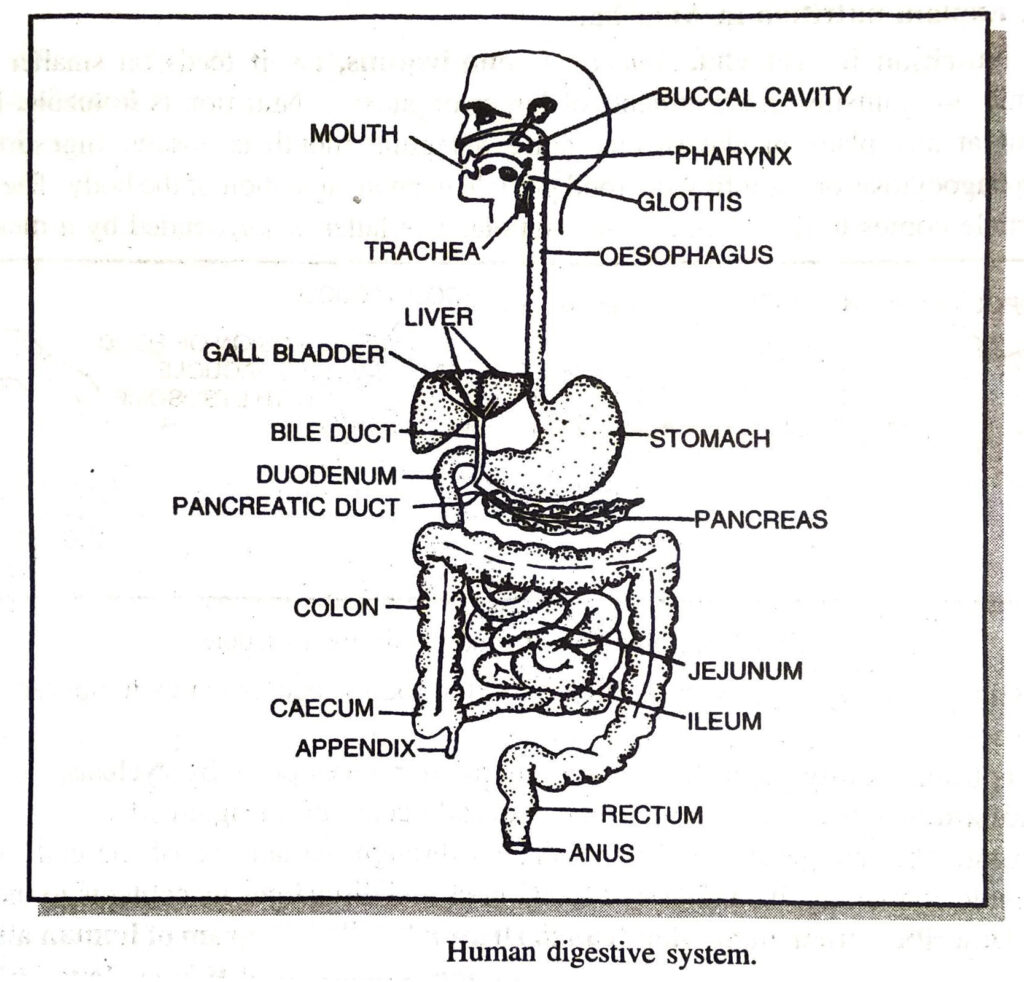
Large intestine. The large intestine is about 1.5 metres long. It is divided into following parts, i.e. the vermiform appendix, the colon and the rectum. Caecum is a blind tube and represented by vermiform appendix (5-8 cm) and is present below the junction of small and large intestine. Rectum is the last part and opens to the outside by anus guarded by anal sphincter.
Q. 6. Describe the process of digestion of food in man.
Or
Discuss role of digestive enzymes in the digestion of food.
Ans. Digestion. The process of conversion of non-diffusible form of food into the simple and diffusible form by chemical and mechanical processes in the alimentary canal is called digestion.
1. The process of digestion starts in the mouth cavity and is completed in the intestine.
2. In the mouth, food gets mixed up with saliva secreted by salivary glands.
3. Saliva contains an enzyme ptyalin (salivary amylase) which breaks polysaccharide starch into disaccharide maltose.

4. The food from the mouth cavity called bolus passes into the stomach through the oesophagus.
5. The gastric glands of the stomach secrete gastric juice which contains hydrochloric acid, protein digesting enzyme-pepsin, rennin and mucus are also components of gastric juice.
6. Pepsin breaks down proteins into peptones and proteoses in acidic medium of stomach.
7. Rennin curdles the milk.
8. Muscles present on the wall of stomach churn and propel the food called chyme forward into duodenum.
9. The digested food moves from stomach to duodenum of the small intestine.
10. Duodenum receives bile from juices from liver and pancreatic juice from pancreas.
11. The pancreatic juice contains trypsin, amylase and lipase.
12. The proteins, fats and carbohydrates are further digested into diffusible form amino acids, glycerol and fatty acids, glucose and fructose.
13. The intestinal juice consists of amylolytic, proteolytic and lipolytic enzymes.
14. Finally, the digestion is completed in the ileum with the secretion of the intestinal juice by intestinal glands.
15. Emulsion form of food called chyle is ready for absorption.
Q. 7. What are the functions of liver and pancreas ?
Ans. Functions of liver
1. Role in digestion. Bile produced by liver helps in the digestion of food as follows:
(a) It emulsifies the fats with its salts.
(b) It prevents decomposition of food by checking the growth of bacteria.
(c) It neutralizes the acid coming from the stomach along with food and provide alkaline medium in the intestine required for action of enzymes of pancreas and intestinal glands.
2. Regulation of Blood Sugar. The liver separates the excess of sugar from the blood and stores it in its cells as glycogen (animals starch).
3. Formation of Glycogen from non-carbohydrate Sources.
4. Deamination. In the liver, the amino acids coming from the alimentary canal are sorted out, ammonia is formed. Ammonia is converted to less toxic urea.
5. Excretion. Liver collects haemoglobin of the worn-out red blood corpuscles and changes it into bile pigments.
Functions of Pancreas
1. The pancreatic gland cells (acini) secrete pancreatic juice. It is drained by pancreatic duct to small intestine, where it helps in the digestion of food.
2. The special patches of gland cells called Islets of Langerhans. They have a-cells which produce glucagon and B-cells produce insulin hormones. These hormones are carried by blood stream and regulate the amount of glucose in the body.
SHORT ANSWER TYPE QUESTIONS
Q. 1. List six features of living organisms.
Ans. Features of living organisms :
1. Growth
2. Movement
3. Cellular body
4. Nutrition
5. Respiration
6. Reproduction.
Q. 2. What are life processes ?
Ans. Life processes. Every living organisms takes food, derives energy, removes waste materials from their bodies and responds to changes in their environment. These activities are called life processes. In all living organisms there occur the basic life processes such as nutrition, respiration, transportation, excretion and reproduction, which are necessary for survival.
Q. 3. (i) Coin the term for the processes which together perform the maintenance in living body.
(ii) Why are these processes required ?
(iii) What is the basic requirement for maintenance of body ?
Ans. (i) Life processes.
(ii) Maintenance processes are required to prevent the damage and breakdown of the body.
(iii) Energy.
Q. 4. List the molecules and processes which provide energy.
Ans. (i) Carbon based molecules of food provide energy. (ii) Nutrition and respiration processes transfer energy from outside source to body.
Q. 5. (i) Name the process cess which help in transfer of food substances in in the body of multicellular organism.
(i) Name the process by which metabolic wastes are removed.
Ans. (i) Transportation. Wait (ii) Excretion.
Q. 6. Why are plants called autotrophs ?
Ans. Nutrition in plants. Plants are mostly autotrophs, i.e., they synthesize their own food. Plants are capable of trapping solar energy and convert into chemical energy stored in plants capable of carrying out photosynthesis are called photoautotrophs.
Q. 7. Write a note on saprophytic nutrition.
Ans. Saprophytic nutrition (Sapros = rotten; phyton = plant). In this the organism releases some juices to soften or digest the food and then absorbs the nutrient. Thus they decompose the dead organic matter into simpler substances. Fungi (yeast, moulds, mushrooms) and many bacteria are saprophytic in nutrition.
Q. 8. What do you understand by parasitic nutrition ?
Ans. Parasitic nutrition (Para = besides ; sitos = food). In this an organism (parasite) depends upon the organism (host) for its nutritional requirements. Many bacteria, viruses, fungi, some non-green plants and many animals have this mode of nutrition. Examples. Cuscuta, Orchids, Ticks, Lice, Leeches, Tapeworms.
Q. 9. What is meant by photosynthesis ?
Ans. The manufacture of organic compounds from carbon dioxide and water in the presence of sunlight inside the chlorophyll containing cells of the plant is called photosynthesis. The overall reaction of photosynthesis is

Q. 10. What are the basic requirements for the process of photosynthesis?
Ans. Basic requirements for photosynthesis. CO₂, water, chlorophyll and solar energy. HOOL Photosynthesis is a photo-biochemical process in which energy rich compounds such as carbohydrates (glucose) are synthesized from simple inorganic compounds like CO₂ and water in the presence of sunlight and chlorophyll. Oxygen is a by-product.
Q. 11. List the events which occur during photosynthesis.
Ans. The following events occur during photosynthesis :
1. Absorption of light energy by chlorophyll.
2. Conversion of light energy to chemical energy and splitting of water molecules into hydrogen and oxygen.
3. Reduction of carbon dioxide to carbohydrates.
Q. 12. What is the role of water in photosynthesis ?
Ans. Water is an essential raw material during photosynthesis. Water is absorbed by roots and transported to leaves via xylem tissue. About 1% of the total water absorbed by roots is used in photosynthesis. Water is the source of O₂ released during photosynthesis.
Q. 13. Give an outline of e of Calvin-Benson Cycle.
Ans.Melvin Calvin and Andy Benson discovered this cycle, hence it is called CalvinBenson cycle.
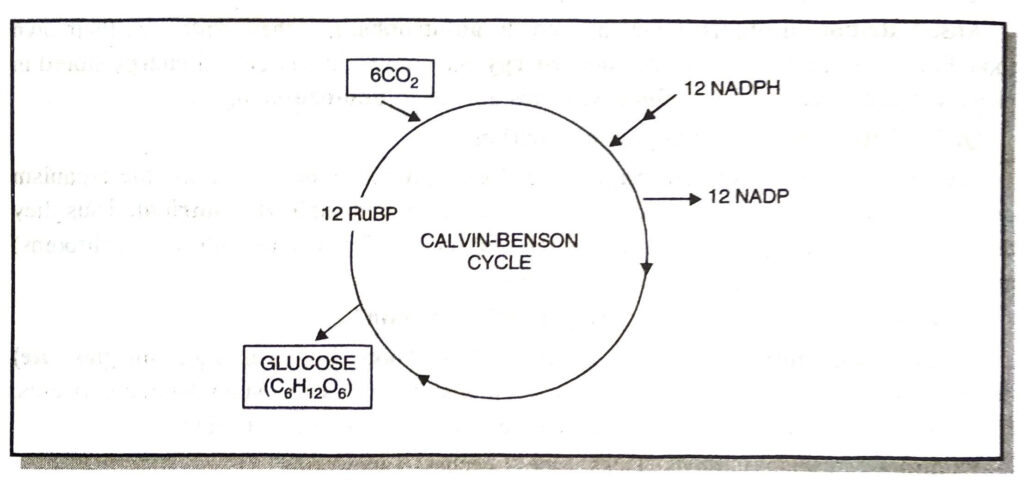
Q. 14. Differentiate the following:
(i) Respiration and Photosynthesis
(ii) Light reaction and Dark reaction
Ans. (i) Differences between Respiration and Photosynthesis
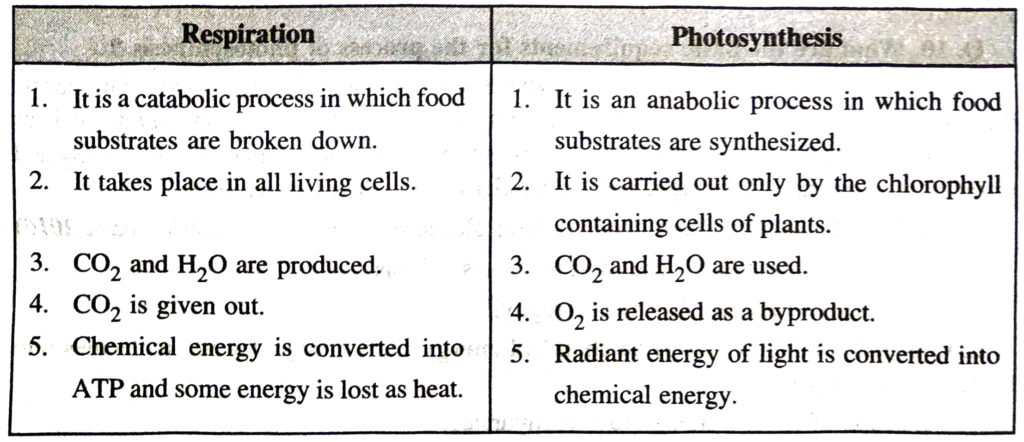
(ii) Differences between Light reaction and Dark reaction in Photosynthesis
| Light reaction | Dark reaction |
|
1. Light reaction is light induced chemical reaction,
2. Energy rich compounds like ATP and NADP.H₂ are synthesized.
3. Oxygen is liberated.
4. It takes place in the grana of the chloroplasts.
|
1. Dark reaction requires no light and is purely enzyme controlled reaction.
2. The energy rich compounds are used to produce the organic compounds.
3. No liberation of oxygen.
4. It takes place in the stroma of chloroplasts.
|
Q. 15. Write the differences between Herbivores and Carnivores.
Ans. Differences between herbivores and Carnivores
| Herbivores | Carnivores |
|
1. These animals eat green plants as food.
2. Examples: Rabbit, Deer, Grasshopper.
|
1. They eat flesh of other animals.
2. Examples: Frog, Hawk, Tiger.
|
Q. 16. Differentiate holozoic and saprozoic mode of nutrition.
Ans. Differences between holozoic nutrition and saprozoic nutrition
| Holozoic nutrition | Saprozoic nutrition |
|
1. Solid food is ingested.
2. Digestion occurs always inside the body.
3. Examples
Such a mode of nutrition is found in animals and some protozoans.
|
1. Fluid food is absorbed from the body surface.
2. Digestion occurs outside the body.
3. Examples
Occurs in some of the parasites (e.g. Tapeworm) and most of fungi.
|
Q. 17. Micro-organisms can satisfy their food needs simply by engulfing food. Why is this inadequate for multicellular organisms. Compare the digestive system of an Amoeba with that of earthworm.
Ans.The Amoeba’s digestive system consists only of food vacuoles and lysosomes. It simply engulfs a food particle, digests it in the vacuole and releases the waste. On the other hand, in the earthworm the food travels through various organs.
Q. 18. How does Paramecium obtain food?
Ans. Paramecium is a unicellular organism. The cell has a definite shape and food is taken in at a a specific spot. Food is moved to this spot by the movement of cilia alongwith water current which cover the entire surface of the cell.
Q. 19. What is the difference between intercellular and intracellular digestion ?
Ans. Intracellular digestion occurs within a cell, whereas extracellular (intercellular) digestion occurs when the digestive enzymes secreted by a cell pass into the environment surrounding the cell and these digest the food materials.
Q. 20. What are enzymes ? Name two factors that influence the action of enzymes.
Ans. Enzymes. These are biocatalysts. They are proteinaceous substances, which either initiate or accelerate metabolic reaction without undergoing any change in themselves, thus also called as biocatalysts.
Factors that influence action of enzyme
Temperature and pH (degree of acidity and alkalinity).
Q. 21. What is dentition? Give the dental formula of man.
Ans.Dentition. The number and arrangement of teeth in the jaws of an animal is called dentition. The teeth are thecodont, diphyodont and heterodont.
Dental formula of Man.
For milk teeth- I 2/2 ; C 1/1; pm 0/0 ; m 2/2 = 20
For permanent teeth- I 2/2 ; C 1/1; pm 2/2 ; m 3/3 = 32
The initials I, C, pm and m refer to incisors, canines, premolars and molars respectively. The total at the end refers to the number of teeth in whole skull. In children molars appear at the site of premolars.
Q. 22. What are the functions of tongue ?
Ans. Functions of tongue.
(i) It helps in mastication of food.
(ii) It bears taste buds and helps in the sensation of taste of food.
(iii) It takes part in the modification of sound production.
(iv) It acts as a brush and cleans the teeth.
(v) It aids in deglutition of food.
Q. 23. State the functions of stomach.
Ans. 1. Storage of food.
2. Mechanical breakdown of food.
3. Partial digestion of food.
Q. 24. Write the functions of large intestine.
Ans. Functions of large intestine
Colon. (i) Its wall absorbs the water from undigested food.
(ii) Absorption of digested food also takes place in this region which has not been absorbed by ileum.
Rectum. It carries faeces to anus for removal.
Q. 25. What is a digestive gland ? Name the various digestive glands of man and their secretions.
Ans.Digestive gland. A gland that secretes digestive juice which is helpful in the digestion of food is called a digestive gland.
Digestive glands of Man
| Name of digestive gland | Name of digestive juice/Secretion |
|
1. Salivary gland
2. Gastric glands
3. Pancreas
4. Liver
5. Intestinal glands
|
Saliva
Gastric juice
Pancreatic juice
Bile
Intestinal juice
|
Q. 26. What is the utility of components of food ?
Ans.Utility of components of food.
1. Carbohydrates are mainly used for producing energy.
2. Fats serve as stored concentrated fuel for energy production.
3. Proteins are mainly used to build up tissues.
4. Mineral salts and vitamins regulate metabolic processes and growth.
5. Water is essential for all biological activities.
Q. 27. Define digestion. Why is digestion necessary ?
Ans. Digestion. The process of conversion of non-diffusible form of food into the simple and diffusible form by chemical and mechanical processes in the alimentary canal is called digestion.
Digestion is necessary because :
1. Large molecules must be broken down into molecules small enough to permeate the living membranes.
2. Insoluble substances must be changed into substances which can be carried in solution around body.
3. Complex molecules must be converted into molecules simple enough to be used by cells in the assimilation.
Q. 28. Differentiate extracellular digestion and intracellular digestion.
Ans. Differences between extracellular digestion and intracellular digestion
| Extracellular digestion | Intracellular digestion |
|
1. Digestion occurs in the alimentary canal and outside the cells.
2. Digested food substances pass into cells.
3. Occurs in higher organisms.
|
1. Digestion occurs inside the food vacuoles in a cell.
2. Digested food substances pass from vacuoles into the cytoplasm.
3. Found in lower organisms.
|
Q. 29. Discuss the fate of food in the oral cavity of man.
Ans. Fate of food in mouth cavity
The partial digestion of food occurs due to the action of Ptyalin enzyme. It acts on starches and forms maltose.
The sufficiently masticated, partially digested food forms bolus. It is swallowed into oesophagus through gullet by raising the throat aided by the muscles of pharynx.
Q. 30. Describe the fate of food in the stomach.
Ans. Fate of food in stomach. The peristaltic waves of the stomach wall churn the food Best C into a thick pulpy mass, called chyme and carries out thorough mixing of gastric juice with it. Gastric juice contains HCl, propepsin and prorennin.
1. HCl activates pepsinogen to pepsin and prorennin to rennin. It also disinfects the food.
2. Pepsin. Active pepsin hydrolyses the protein molecules into proteoses and peptones.
3. Rennin. In presence of HCI and Ca++ ions the soluble milk protein caseinogen changes into soluble casein. Its secretion is greatly reduced in the adults.

Semi-solid, semi-digested food called chyme is pushed into duodenum through pyloric aperture.
Q. 31. Write the enzymes of the pancreatic juice, the substrates they digest and the products of their digestive action.
Ans. Enzymes of the pancreatic juice

Q. 32. Describe the role of intestinal juice.
Ans. Intestinal juice too is alkaline (pH 8.3). It has many enzymes. This juice acts in the cavity of small intestine.
(i) Intestinal amylase hydrolyses the remaining starch and glycogen to maltose.
(ii) Maltase changes maltose to glucose.
(iii) Sucrase converts sucrose into glucose and fructose.
(iv) Lactase hydrolyses lactose (milk sugar) to glucose and fructose.
(v) Dipeptidases hydrolyse dipeptides to amino acids.
(vi) Intestinal lipase splits emulsified fats into fatty acids and glycerol.
Thus mainly carbohydrates are digested into simple sugars and fats are digested into fatty acids and glycerol.
Alkaline emulsion of digestion products formed in the small intestine is called chyle.
Q. 33. Describe digestion of fats in the small intestine.
Ans. Digestion of fats in the intestine
Lipases are the enzymes which hydrolyse fats. They act only on the water adjoining surfaces of fat droplets. Thus before lipase acts on fats, the large fat droplets are broken into tiny droplets in a fine small globules. Thus fats are emulsified by the bile salts present in bile. The emulsified fats are acted upon by pancreatic lipase (streapsin) emulsified fats into fatty acid and glycerol. The intestinal lipase break down remaining emulsified fats into fatty acids and glycerol.
Fatty acids and glycerol are the major end products.
Q. 34. Explain absorption.
Ans. Absorption. The process of diffusion of digested food into blood present in the blood capillaries of small intestine is called absorption.
Glucose, amino acid, vitamins, mineral salts and water diffuses into blood present in blood capillaries of numerous villi of the small intestine. The fatty acids and glycerol diffuses into lymph present in lymph vessels called lacteals. The digested food is carried to the liver by the hepatic portal vein. The fatty acid and glycerol unite in lymph to form fat. Most of the fat passes as a milky emulsion. After absorption, the undigested food passes into large intestine.
Q. 35. Explain Balanced diet.
Ans. Balanced diet. It is not enough that all the essential components are present in the diet. The food intake must be adequate, i.e. ideally each meal should provide sufficient;
(a) growth promoting food
(b) energy providing food.
For a diet to be balanced, the essential dietary components should be present in the correct proportions and must be evenly distributed between carbohydrates, fats, proteins, vitamins, minerals and water.
Q. 36. What is the significance of a balanced diet ?
Ans. Significance of a Balanced Diet
A balanced diet ensures :
1. A normal mental and physical status
2. An increased working capacity
3. The ability to resist diseases.
Q. 37. Mention the role of various constituents of food.
Ans. Role of constituents of food
1. Carbohydrates (simple sugars) provide energy.
2. Proteins are the building materials of body.
3. Fats act as fuels, shock absorbers and maintenance of body temperature.
4. Water act as a biological solvent.
5. Minerals and vitamins act as growth and metabolic regulatory substances.
Q. 38. Write a note on dental caries.
Ans. Dental caries or tooth decay causes gradual softening of enamel and dentine. It starts when bacteria acting on sugars present in oral cavity produce acids that softens or demineralises the enamel. Masses of bacterial cells together with food particles stick to the teeth to form dental plaque. Saliva cannot reach the tooth surface to neutralise the acid as plaque covers the teeth. Brushing the teeth after eating removes the plaque before the bacteria produce acids. If untreated, microorganisms may invade the pulp, causing inflammation and infection.
VERY SHORT ANSWER TYPE QUESTIONS
Q. 1. Is visible movement the only defining characteristic of life?
Ans. No.
Q. 2. What kind of movements are shown by viruses ?
Ans. Molecular movements.
Q. 3. When do viruses show movements ?
Ans.Viruses show molecular movements when they infect some other cell.
Q. 4. List three characteristics of living organisms.
Ans. 1. Growth
2. Movements
3. Repair and maintenance of their structures.
Q. 5. What are life processes ?
Ans.The processes which together perform the maintenance jobs are collectively termed as life processes.
Q. 6. Why are maintenance processes required?
Ans.They are required to prevent breakdown.
Q. 7. What is the basic requirement of maintenance ?
Ans. Energy is needed by living organisms for maintenance.
Q. 8. What are sources of energy for living organisms?
Ans. Carbon based molecules i.e. food obtained from environment.
Q. 9. List the common reactions required to obtain energy from carbon based molecules.
Ans.Oxidising-reducing reactions.
Q. 10. Name any four life processes required for maintenance.
Ans.1. Nutrition
2. Respiration shee
3. Transportation
4. Excretion.
Q. 11. What are nutrients ?
Ans.The substances which provide materials for growth, energy and maintenance are called nutrients.
Q. 12. What is nutrition? Why is it necessary ?
Ans. Nutrition. The sum total of processes by which living organisms obtain food materials and prepare them for use in the growth, repair and providing energy is termed nutrition.
Q. 13. Give two examples of plant parasites.
Ans.Plant parasites.
(i) Cuscuta
(ii) Loranthus.
Q. 14. What name is given to the process of splitting of water during light reaction ?
Ans.Photolysis.
Q. 15. Name the tissue which transports soluble products of photosynthesis in plants.
Ans. Phloem.
Q. 16. What is holozoic nutrition ?
Ans. Holozoic nutrition. When the nutrient are ingeshed as solid organic food matter, it is called holozoic nutrition.
Q. 17. Where does mastication of food occur?
Ans. Mastication of food takes place in the mouth (oral cavity).
Q. 18. What are the advantages of cooked food ?
Ans.Human beings consume cooked food. Cooking makes it soft, palatable, tasty and easier to digest.
Q. 19. What is the food of Amoeba ?
Ans.Food of Amoeba consists of small protozoans, algae, rotifers bacteria and diatoms. It also feeds upon bits of organic matter.
Q. 20. Is food vacuole of Amoeba, temporary structure or a permanent one ?
Ans. Food vacuole is a temporary structure.
Q. 21. Name four kinds of teeth.
Ans. Incisors, canines, premolars and molars.
Q. 22. Give two functions of pancreas.
Ans. (a) Secretion of pancreatic juice. (b) Secretion of insulin and glucagon hormones.
Q. 23. Which carbohydrate is not digested by man ?
Ans.Cellulose.
ADDITIONAL IMPORTANT QUESTIONS
LONG ANSWER TYPE QUESTION
Q. Describe the mechanism of breathing in human beings.
Ans. Mechanism of breathing
Breathing. It is simply inhaling fresh air rich in oxygen and exhaling foul air rich in carbon dioxide. Respiratory system of man consists of:
(A) Respiratory tract.
(B) Respiratory organs (lungs).
Respiratory tract. It is the tract or the path through which fresh air enters the body, reaches the lungs and foul air (rich in CO₂) leaves the lungs to come out. It consists of Nasal cavity → Pharynx → Larynx → Trachea → Bronchi → Bronchioles → Alveoli (of Lungs).
Breathing is accomplished through changes in size and air pressure of chest cavity. It involves Inspiration and Expiration.
Inspiration
Intake of fresh air is called inspiration. It occurs when the chest cavity is increased in size and therefore decrease in pressure.
Expiration
The expulsion of foul air (rich in CO₂) from lungs is called expiration. It results when the chest cavity is reduced in size.
SAQ SHORT ANSWER TYPE QUESTIONS
Q. 1. What is respiration ?
Ans. Respiration is a property of all living organisms. It is a biochemical process whereby living organisms produce energy for their metabolic processes. It takes place in mitochondria. The energy may be required for movement, synthesis of essential chemicals for use in metabolism or for heat production. The energy is released from the breakdown of food and waste products are released at the same time.
Q. 2. Differentiate Respiration and Combustion.
Ans. Differences between respiration and combustion
| Respiration | Combustion |
|
1. It occurs in living cells.
2. It is a complex biochemical process controlled by several enzymes.
3. Heat produced is much less.
4. There is no flame or light produced.
|
1. It occurs in non-living and dead cells.
2. It is a chemical process.
3. A large amount of heat is produced.
4. This process is usually accompanied with flame and light.
|
Q. 3. Which part of root is involved in exchange of respiratory gases ?
Ans. (i) Root hairs.
(ii) In older root it occurs through lenticels.
Q. 4. What are stomata and lenticels ?
Ans.Stomata. These are tiny apertures present on the surface of the leaves. Exchange of gases occurs through stomata.
Lenticels. These are tiny apertures in the protective layer of dead cells of older roots of plants through which gaseous exchange occurs between soil and inner living cells.
Q. 5. Describe alcoholic fermentation.
Ans.Alcoholic fermentation is carried out by yeasts, certain bacteria and even by green plants in the absence of oxygen. The following equation represents the overall changes involved in alcoholic fermentation :
Alcoholic fermentation which is brought about by the activity of yeast is an enzymatic process and is due to an enzyme called zymase which is produced by the yeast cells.
Q. 6. Describe lactic acid fermentation.
Ans. Lactic acid fermentation is seen in certain bacteria called lactic acid bacteria. These bacteria play an important role in souring of milk in which they convert the milk sugar (lactose) into lactic acid.
Q. 7. Name the respiratory organs of :
(i) fish (ü) mosquito (iii) earthworm (iv) dog.
Ans. (i) Gills (ii) Trachea (iii) Body wall (iv) Lungs.
Q. 8. How is respiration different from breathing ?
Ans. Differences between Breathing and Respiration
| Breathing | Respiration |
|
1. It is ventilation or bringing in of oxygenated air and giving out of deoxygenated air.
2. It is a physical process.
3. Breathing does not liberate energy.
4. It is restricted to organs where gaseous exchange occurs between blood and atmospheric air.
|
1. Respiration of animals includes breathing, gaseous exchange and catabolic breakdown of food.
2. Respiration is both a physical and physiological process.
3. It liberates energy.
4. Respiration involves every living cell of the body.
|
Q. 9. Rewrite the following words in proper sequence to show the passage of air through the breathing organs: Lungs, Glottis, Pharynx, Bronchi, Fine bronchiole, Trachea, Bronchioles, Nasal Chamber, Larynx, External naris, Internal naris.
Ans. External naris → Nasal Chamber → Internal naris → Pharynx → Glottis → Larynx → Trachea → Bronchi → Bronchioles → Fine bronchioles → Lungs.
Q. 10. Briefly explain the human respiratory system.
Ans. Human Respiratory System. Respiratory system of human beings and other mammals consists of air passage or respiratory tract, a pair of lungs.
Respiratory tract is made up of nostrils, nasal cavity, pharynx, larynx, trachea and bronchi.
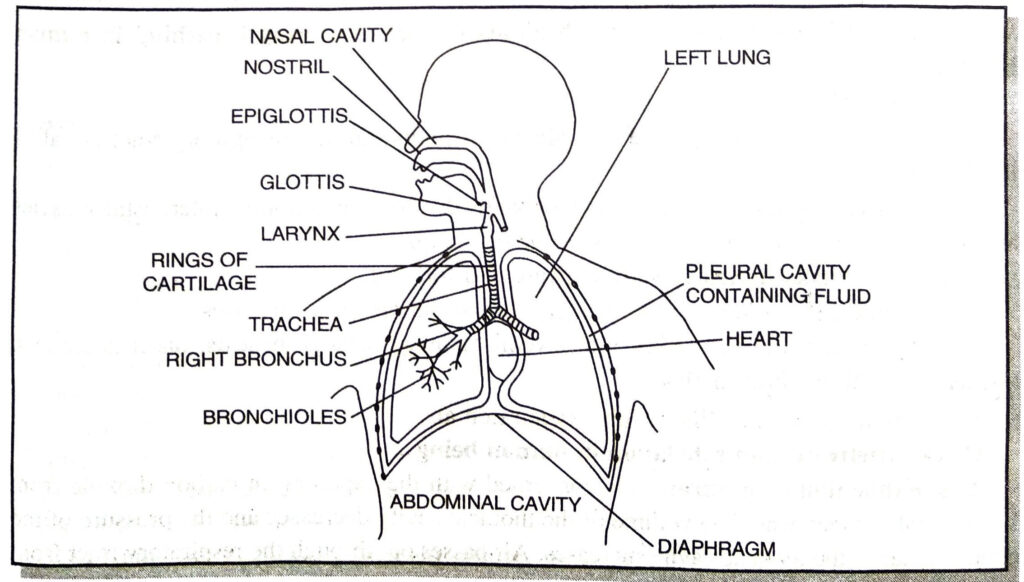
The lungs are a pair of brownish grey coloured spongy structures situated in the thoracic cavity.
The left lung consists of two lobes while the right lung consists of three lobes. Each lobule of a lung consists of bronchioles which terminate into a bunch of spherical thin walled air sacs, called alveoli.
Each alveolus or air sac has a diameter of 75 to 300 microns and has a very thin wall. The walls of the alveoli are elastic and are supplied with capillaries. Gases are exchanged between the capillaries and the air sacs through these thin walls.
Q. 11. Give a brief account of branchial respiration.
Ans. Branchial respiration. Gills are the respiratory organs of most of aquatic animals. Gills are of two kinds : external and internal gills. External gills are present in some annelids and young ones of a few insects, the internal gills are found in prawn, pila, fishes, tadpole larva of frog.
Q. 12. Briefly explain gaseous exchange in alveoli.
Ans. Gas Exchange in Alveoli
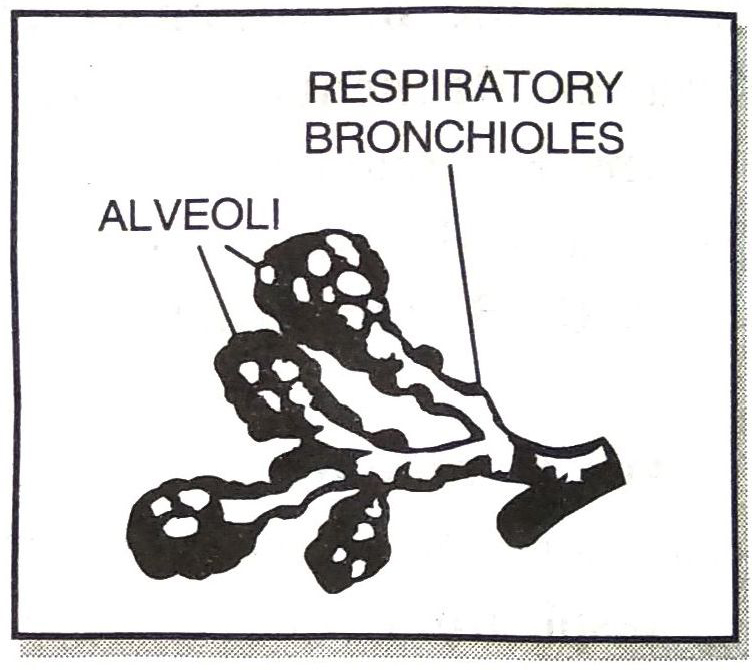
1. Alveoli have a higher concentration of oxygen as compared to the blood in capillaries.
2. Therefore, O₂ diffuses into the capillaries and combines with haemoglobin of red blood cells to form oxyhaemoglobin to be transported throughout the body.
3. Blood rich in carbon dioxide, i.e. the deoxygenated blood enters the capillary network of alveoli.
4. CO₂ diffuses into the alveolar cavity because of its higher concentration in the blood.
Q. 13. Explain the process by which inhalation occurs during breathing in human beings.
Ans. Inhalation
1. The entry of air from outside into alveoli of lungs through respiratory tract is called inhalation.
2. The air enters when thoracic cavity expands due to contraction of intercostal muscles attached to ribs and peripheral muscles of the diaphragm.
3. Thus the thorax moves upward, outward and forward.
4. It increases the volume of thoracic cavity and the pressure decreases.
5. Thus air from outside rushes into alveoli of lungs through nostrils, nasal chambers, trachea, bronchi and bronchioles.
6. The alveolar sac gets filled with oxygen rich air.
Q. 14. Briefly explain exhalation in human beings.
Ans. Exhalation or Expiration is concerned with the expelling of carbon dioxide from lungs. It takes place when the volume of the thoracic cavity decreases and the pressure of the contained air in the thoracic cavity increases. Air passes out through the respiratory tract from the lungs.
Q. 15. Write the summary of oxygen transport in the body.
Ans. Summary of oxygen (O₂) transport.

Q. 16. List three differences between respiration in plants and respiration in animals.
Ans.Differences in respiration in plants and animals
| Respiration in plants | Respiration in animals |
|
1. All the cells of plant parts (root, stem, leaves) perform the respiration individually.
2. There is little transport of gases from one part to the other.
3. Rate of respiration is low.
|
1. It is performed by specific respiratory organs for all the cells of body.
2. Transport of gases is maximum.
3. Rate of respiration is high.
|
VERY SHORT ANSWER TYPE QUESTIONS
Q. 1. Which carbohydrate serves as roughage in our body ?
Ans. Cellulose.
Q. 2. What is main respiratory substrate ?
Ans. Glucose (6 carbon molecules).
Q. 3. One molecule of glucose is broken down into which 3-carbon molecules ?
Ans. Pyruvate.
Q. 4. Name the end products of pyruvate in case of alcoholic fermentation.
Ans.CO₂ and Ethanol.
Q. 5. What is the end product of pyruate during anaerobic respiration in muscle cells ?
Ans. Lactic acid.
Q. 6. Name two organisms which respire anaerobically.
Ans. Ascaris and Bacteria.
Q. 7. Expand ATP and ADP.
Ans. ATP Adenosine triphosphate and ADP – Adenosine diphosphate.
Q. 8. What is the rate of breathing in man?
Ans.12-14 times per minute.
Q. 9. Name the respiratory pigment present in blood.
Ans. Haemoglobin present in R.B.C.
Q. 10. Name a few respiratory disorder.
Ans. Coughing, Hypoxia, Anaemia, Pneumonia, Emphysema and Tuberculosis.
Q. 11. During which part of the day plants respire ?
Ans. Throughout the day.
Q. 12. How many alveoli are present in human lung? What is the total surface area?
Ans. About 750 million alveoli with a total surface area of about 80 square metres.
Q. 13. Name the cells which transport oxygen in the body.
Ans. Red Blood Corpuscles (RBCs).
ADDITIONAL IMPORTANT QUESTIONS
LONG ANSWER TYPE QUESTIONS
Q. 1. Show the circulation of blood in man with the help of a sketch only.
Ans. Blood, circulation in man
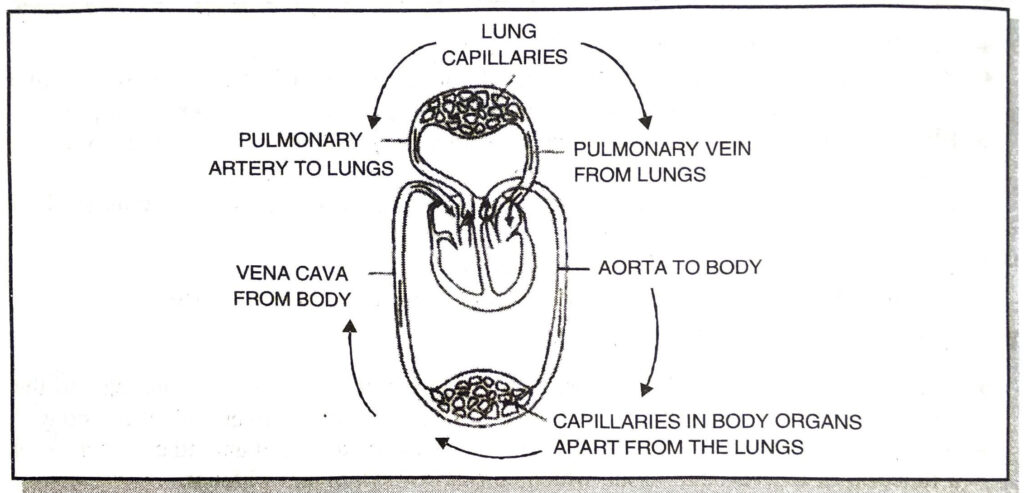
Q. 2. Briefly describe the working mechanism of the human heart.
Or
Write function of human heart.
Ans. Function. The circulation of blood in the body takes place due to the pumping action of the heart. The heart receives blood from the veins and pumps it into the arteries. This pumping action is caused by the alternate contraction and relaxation of the muscles of the heart. Working. During relaxation, both the atria (singular – atrium) get filled with blood. The left atrium gets filled with the oxygenated blood brought by pulmonary veins from the lungs while the right atrium with the deoxygenated blood brought by inferior vena cava and superior vena cava from different parts of the body.
When atria contract, the bicuspid and tricuspid valves open. As a result of this, the oxygenated blood enters from the left atrium into the left ventricle while deoxygenated blood from the right atrium enters into the right ventricle.
When the ventricles contract, the bicuspid and tricuspid valves get closed. Owing to this, the oxygenated blood from the left ventricle enters into the aorta which supplies it to different parts of the body through its branches, while the deoxygenated blood from the right ventricle is carried to the lungs through pulmonary artery for purification. From this, it is obvious that blood circulates in the body due to the pumping action of the heart.
Q. 3. State differences between artery and vein.
Ans. Differences between Artery and Vein
| Artery | Vein |
|
1. An artery carries blood from the heart to different organs of the body.
2. Blood flows under great pressure.
3. It has a thick muscular wall.
4. It is non-collapsible.
5. It contains oxygenated blood (Exception pulmonary artery).
6. Valves are absent.
7. Mostly deep seated.
|
1. A vein collects blood from different organs of the body and brings it back to the heart.
2. Blood flows under less pressure.
3. Wall is thin.
4. It is collapsible.
5. It contains deoxygenated blood (Exception pulmonary vein)
6. Valves are present.
7. Mostly superficial.
|
Q. 4. (a) What is blood pressure ? (b) What are normal value of systolic and diastolic blood pressure (c) How is it measured ? (d) Name the instrument used to measure blood pressure.
Ans. BLOOD PRESSURE
(a) Blood pressure is the force that blood exerts against the wall of a vessel. This pressure is much greater in arteries than in veins. The pressure of blood inside the artery during ventricular systole is called systolic pressure and pressure in artery during ventricular diastole is called diastolic pressure.
(b) The normal systolic pressure is about 120 mm of Hg and diastolic pressure is 80 mm of Hg.
(c) Measurement of blood pressure.
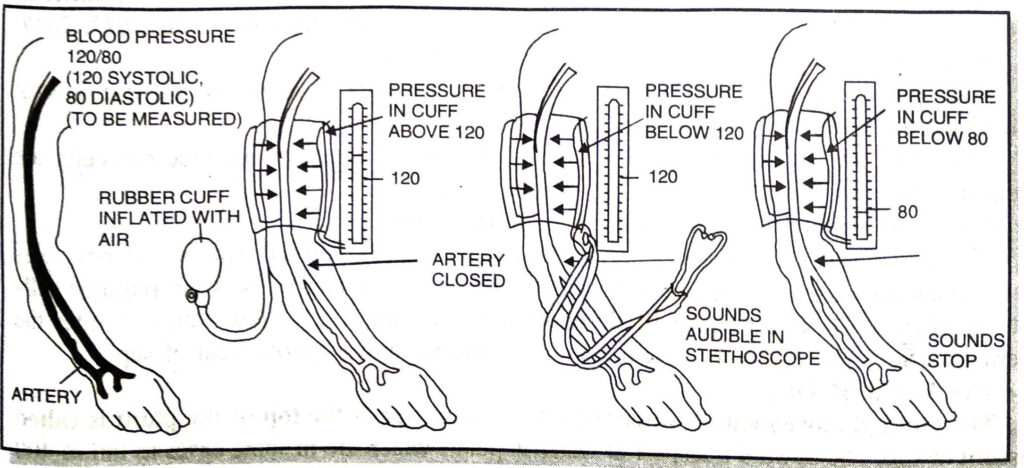
(d) Blood pressure is measured with an instrument called sphygmomanometer.
| High blood pressure is also called hypertension and is caused by the constriction of arterioles, which results in increased resistance to blood flow. It can lead to the rupture of an artery and internal bleeding. |
Q. 5. Write a note on mechanism of blood clotting.
Ans. Blood Clotting. 1. At the site of injury, as the blood flows out blood platelets disintegrate and release enzyme thromboplastin.
2. Thromboplastin transforms the inactive prothrombin into active thrombin.
3. Thrombin converts soluble protein fibrinogen into insoluble fibrin.
4. This forms a meshwork of fibrils which entangle blood corpuscle and transforms the liquid blood into a gel or clot.
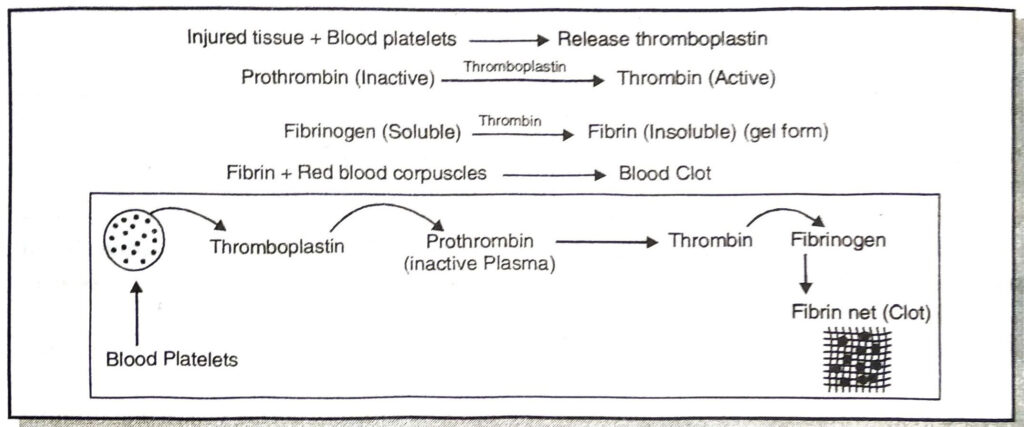
5. Unless the blood clots at the site of the injury, there will be loss of blood (blood haemorrhage).
6. Such a loss of blood will lead to death of the person.
Q. 6. Describe transport of the following materials in plants (i) water (ü) minerals (iii) food.
Ans. (i) and (ii) Transportation of water and minerals
Water and minerals are mainly absorbed by roots. The area of young roots where most of the absorption takes place is the root hair zone.
This zone is the area of greatest permeability. Root hairs, extension of epidermal cells, are delicate structures and last for not more than two days.
Passage of water in root or pathway of water in root
The entry of water and minerals into the root hair dilutes the cell sap. Thus water molecules in root hair increase as compared to adjacent cortical cells. Water reaches the passage cells of endodermis. These passage cells lie opposite the xylem. They allow water to enter the pericycle. So, water enters the xylem from pericycle for upward movement of sap.
The Ascent of Sap
The upward movement of water from the root towards the top of the plant is called ascent of sap. The upward transport of water in plants which are in some cases as tall as 400 ft. poses a serious problem.
It is well known fact that water rises upwards in the plants through xylem. Water can rise up in plants rapidly at the rate of 10 to 100 cm per minute.
There is a steady upward movement of water. Another strategy of movement of water is transpiration. As water is lost from exposed surface, regular column of water is maintained in the xylem.
(iii) Translocation of Food Photosyntheates of Organic Solutes
Carbohydrates are mainly being formed in green cells of leaves etc. and are supplied to non-green cells. Food synthesized in leaves is made available to all parts of the plants. Food is transported to shoot apices, new buds, developing fruits etc. in upward direction from storage organs. These storage organs and leaves work as supply point. This transport of organic substances from supply point consumption point in higher plants is known as translocation of organic substances.
Path of Translocation
In vascular tissue, xylem and phloem are main conducting elements. It is clearly established that organic substances are translocated in upward and downward directions through vessels of phloem.
SHORT ANSWER TYPE QUESTIONS
Q. 1. Name the constituents of blood and state the functions of each.
Ans.
| Constituents | Functions |
|
1. Plasma
Fibrinogen
|
It contains proteins as well as organic and inorganic substances in solution.
It transports the food and waste materials, antibodies, enzymes and hormones.
Clotting of blood.
|
| 2. Red blood corpuscles (R.B.Cs.) (Erythrocytes) | They help to transport oxygen. |
| 3. White blood corpuscles (W.B.Cs) |
They help to defend our body against bacteria, as well as the toxins which these organisms may produce.
They also help to remove useless dead tissues from the blood.
|
| 4. Blood Platelets or Throm-bocytes | They play a very important role in bringing about the coagulation of blood. |
Q. 2. State the functions of blood.
Ans. Blood performs a number of functions in the body, the most important of which are as follows:
1. Blood supplies food to all parts.
2. It transports gases in the body.
3. It carries the waste matter formed in the cell to the excretory organs.
4. It regulates the temperature of the body (37° C).
5. It supplies hormones to different parts of the body.
6. It prevents the body from various diseases by destroying the pathogenic germs.
7. It prevents excessive loss of nutrients from cuts and wound by forming a clot.
Q. 3. Describe the structure of human heart.
Ans. Heart.
1. It is a highly efficient, pumping organ of body. Human heart consists of 4 chambers : upper smaller right and left atria (auricles) with thinner wall and lower larger right and left ventricles with thicker walls.
2. Atria open into the respective ventricles by atrioventricular apertures guarded by atrioventricular valves.
3. The two atria are separated from each other by interatrial septum, and the two ventricles are separated from each other by interventricular septum.
4. The sinoatrial node (SAN) or the pacemaker is located in the upper wall of right atrium.
Valves of the heart.
Valves are muscular flaps which prevent the blood to flow back through it. Two types of heart valves are distinguished :
1. The Atrioventicular valves. These valves separate the atria from the ventricles. The right side of the heart possesses the tricuspid valve or right atrioventricular valve and the left side of the heart possesses the bicuspid or mitral valve.
2. Semilunar valves. These are located in the arteries leaving the heart. The pulmonary semilunar valves lies in the opening where the pulmonary trunk leaves the right ventricle and aortic semilunar valve lies at the opening between the left ventricle and aorta.
Q. 4. Draw Human heart and label its parts.
Draw a sectional view of the human heart and label on it, Aorta, Right Ventricle and Pulmonary veins.
Ans. Human Heart
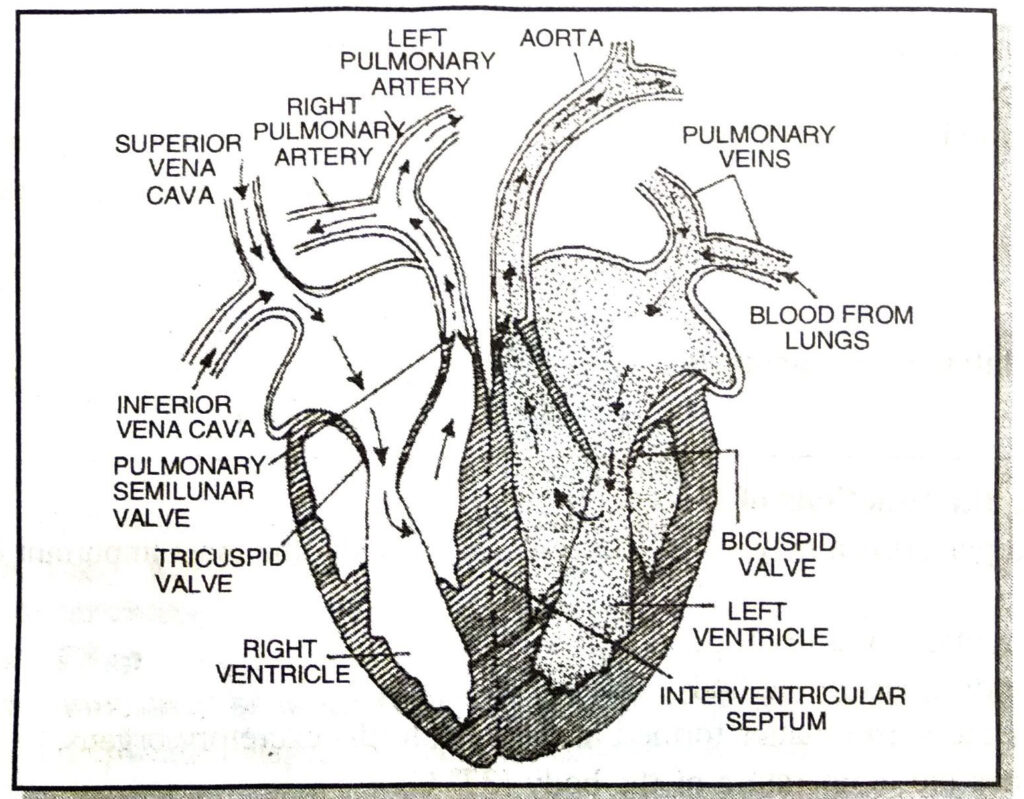
Q. 5. What are hypertension and hypotension ?
Ans. Hypertension. It is the high blood pressure which is caused due to emotions such as worry, excitement, fear etc.
Hypotension. It is the low blood pressure when it falls below the normal level.
Q. 6. Name the three major types of blood vessels. Explain briefly.
Ans. The three main types of blood vessels are : (A) Arteries (B) Veins (C) Capillaries.
Arteries have thick elastic walls and their diameter may be even 1 cm. These blood vessels carry the blood from the heart to the various parts of the body.
Capillaries. Arteries divide into thin arterioles and arterioles further ramify into capillaries (1 micron diameter). The wall of a capillary is made up of a single layer of cells. The muscles and elastic fibres are absent in the capillaries. The walls of these capillaries are so thin that the exchange of food materials, waste materials and gases takes place between the blood and protoplasm of cells (liver, lung etc.) through them.
Veins. The capillaries again reunite to form venules and venules unite to form veins. These venules and veins return the blood to the heart.
Q. 7. What is pace maker ? Why is it called so ?
Or
How is pace maker helpful to a heart patient ?
Ans. Sinuauricular node initiates the heart beat in man. It gives the impulses to the auricles for each contraction precisely and also helps to maintain the number of heart beat. This sinuauricular node is known as “pace maker” of the heart. Artificial pace maker helps the heart patient to maintain the normal heart beat.
Q. 8. What is “lub-dup” ?
Ans. The sound of the heart beat is known as lub-dup. ‘Lub’ is the first sound which is caused by the closure of auriculo-ventricular valves and ‘dup’ is the second sound caused by the closure of the semilunar valves. An instrument, stethoscope is used to hear heart sounds.
Q. 9. Write a note on lymphatic system in human beings.
Ans. Lymphatic system. The lymphatic system comprises colourless fluid, the lymph ; a network of fine channels, the lymphatic capillaries; tubes of varied sizes, the lymphatic vessels; and the lymph nodes. Tissue or interstitial fluid present in the spaces between tissue cells is formed by filtration of protein-free fluid from the blood. Tissue fluid passes into lymphatic capillaries to form lymph. The latter is carried by lymphatic vessels to the veins. Lymphatic vessels have lymph nodes which filter lymph, removing microorganisms and cellular debris and adding lymphocytes.
Q. 10. Write functions of lymph.
Ans. Functions of lymph
1. It drains excess tissue fluid from the extracellular spaces back into the blood.
2. Some of the fluid from the digestive tract is absorbed in the lymph. The lymphatic vessels store this fluid temporarily, and release it gradually so that the kidneys do not face a sudden pressure of urine excretion.
3. It carries carbon dioxide and nitrogenous waste materials that diffuse into the tissue fluid to the blood.
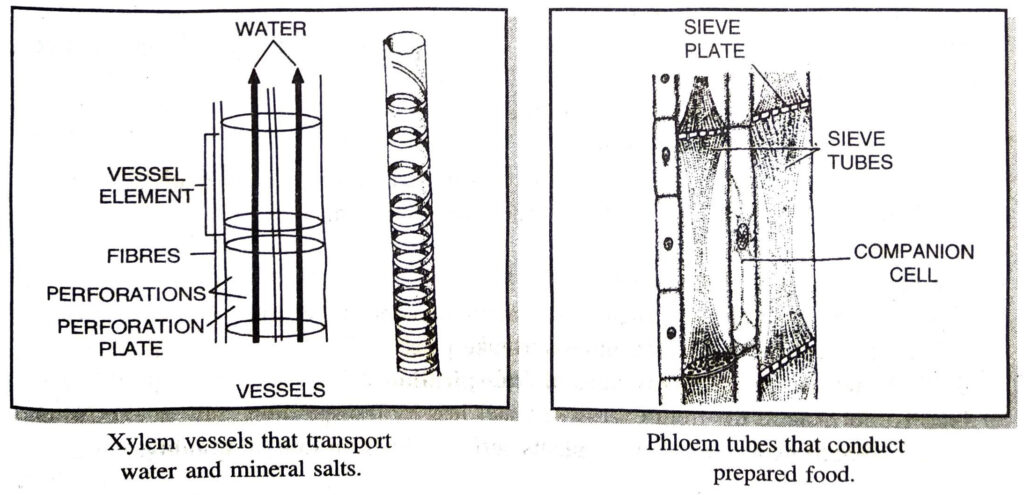
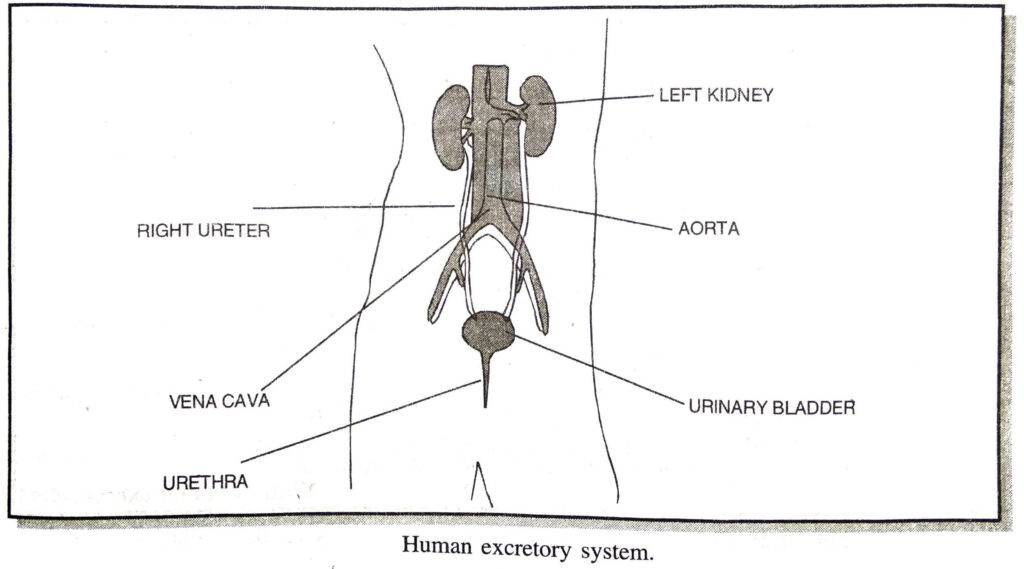
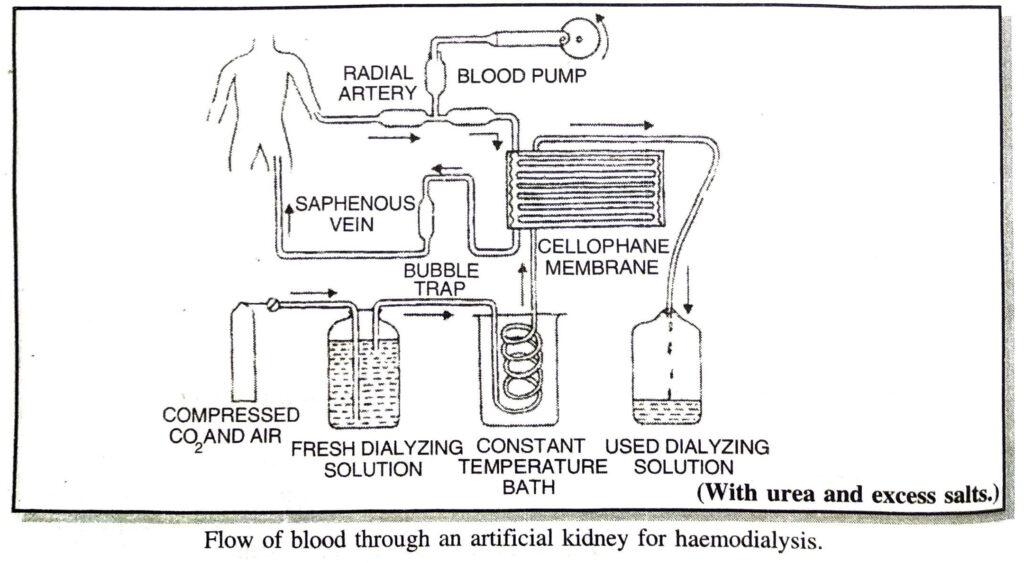
4. It takes lymphocytes and antibodies from the lymph nodes to the blood.
Q. 11. Differentiate between the following:
(i) Auricles and Ventricles
(ii) Right ventricle and Left ventricle
(iii) Erythrocytes (RBCs) and leucocytes (WBCs).
Ans. (i) Differences between Auricles and Ventricles
| Auricles | Ventricles |
|
1. Auricles are receiving chambers, i.e., they receive blood from different organs of the body.
2. Auricles have a thin wall.
3. Auricles are the upper chambers of the heart.
|
1. Ventricles are distributing chambers i.e., they supply blood to different organs of the body.
2. Ventricles have a thick wall.
3. Ventricles are the lower chambers of the heart.
|
(ii) Differences between Right ventricle and Left ventricle
| Right ventricle | Left ventricle |
|
1. Right ventricle is the lower chamber of the right side of the heart.
2. Right ventricle gives rise to the pulmonary artery which carries deoxygenated blood to the lungs.
|
1. Left ventricle is the lower chamber of the left side of the heart.
2. Left ventricle gives rise to the aorta which supplies oxygenated blood to different organs of the body.
|
(iii) Differences between Erythrocytes and Leucocytes
| Erythrocytes (RBCs) | Leucocytes (WBCs) |
|
1. They are circular, biconcave and disc-shaped.
2. They are smaller in size (0.003 inch in diameter).
3. They are devoid of nucleus.
4. They contain haemoglobin and hence red in colour.
5. They are produced in red bone marrow.
6. They are capable of living in healthy state for about 90-120 days.
7. One cubic mm of blood contains 5-5½ million of (RBCs).
|
1. They are irregular in shape.
2. They are larger than RBCs.
3. Nucleus is present.
4. Haemoglobin is absent. Hence they are colourless.
5. They are produced in red bone marrow, spleen and lymph nodes.
6. They live for about 2-3 weeks.
7. One cubic mm of blood is said to contain 8000 cells.
|
Q. 12. Describe the organs of absorption of water in plants.
Ans. In higher vascular plants, absorption of water takes place through the root hairs and very young root surface when root hairs are absent. Except the submerged aquatic plants, all the higher vascular plants absorb water and minerals by the root hairs located some 20-200 mm away from the root tip. Some roots, particularly, the adventitious roots of rhizomes, corms and bulbs do not have root hairs. The ability of absorption is reduced with age as older parts of the roots become suberized. In such cases, new rapidly absorbing cells are differentiated from the meristem.
Q. 13. How is the root system adapted for the function of absorption of water and soluble mineral salts from the soil ?
Ans. 1. The root hair zone is adapted for absorption of water.
2. The meristematic zone is adapted for absorption of soluble minerals.
Q. 14. What is diffusion ?
Ans. Diffusion. The movement of the molecules of gases, liquids and solutes from the region of higher concentration to the region of lower concentration is known as diffusion.
Q. 15. What is osmosis ?
Ans. Osmosis is a special type of diffusion of a liquid, when solvent moves through a semipermeable membrane from a place of higher diffusion pressure to a place of lower diffusion pressure.
Q. 16. How are xylem and phloem well suited for transport of materials in plants? Explain.
Or
How are water and mineral transported in plants ?
Ans. Xylem and phloem are well suited to carry water, minerals and food in plants. Vessels in the xylem are cylindrical in shape with their ends open and are placed one above the other so as to form a continuous column stretching from roots to leaves. So, the water and minerals absorbed by the roots are carried upwards to the leaves. This is known as transportation.
Similarly, phloem has sieve tubes that are also cylindrical but the ends are not open instead covered with sieve (perforated) plate. These tubes are also placed one above the other, forming a continuous column from leaves to other parts of the plant body. The food synthesized in the leaves is carried to other parts of the plant body through phloem. Sucrose is the main form in which carbohydrates are translocated in plants.

Q. 17. Differentiate between the following pairs giving two points in each :
(i) Transpiration and Evaporation
(ii) Stomata and Lenticels.
Ans. (i) Differences between Transpiration and Evaporation
| Transpiration | Evaporation |
|
1. Transpiration is a physiological process.
2. It occurs from the surface of aerial parts of plants.
|
1. Evaporation is a physical process.
2. It occurs directly from the free surface of water.
|
(ii) Differences between Stomata and Lenticels
| Stomata | Lenticels |
|
1. Stomata are minute openings formed in the epidermal layer of green leaves.
2. Through stomata exchange of gases and maximum transpiration take place.
|
1. Lenticels are aerating pores formed in the bark.
2. Through lenticels exchange of gases and a little transpiration take place.
|
Q. 18. Mention any three methods adopted by plants to minimise the transpiration rate.
Ans. Three methods adopted by plants to minimise the rate of transpiration are:
(i) In some cases leaves are rolled to cover stomata (e.g. some grasses)
(ii) The stomata may be sunken (e.g. Nerium)
(iii) In some cases, leaves may be dropped or absent as in most cacti.
Q. 19. Write a short note on root pressure.
Ans. Root pressure. During absorption, water is forced into the xylem vessels by the surrounding cortical cells with a certain force. This induces a pressure which is responsible for ascent of sap to many feet in xylem. This pressure which is developed due to the activity of root is called as root pressure.
Root pressure is a vital phenomenon and depends upon the activity of living root cells. The magnitude of root pressure varies from 2-8 atm.
Q. 20. How is transpiration useful to plants?
Ans. Advantages of transpiration
1. It has cooling effect on the plants as excess of sun’s energy is dissipated.
2. It helps in the removal of excess of water from the plant.
3. It causes ascent of sap.
4. It helps to maintain water cycle.
5. It increases the amount of sugar and mineral content in the fruit.
6. It is needed to permit photosynthesis to take place.
Q. 21. What are the disadvantages of transpiration ?
Ans. 1. More plants die from excessive water loss by transpiration.
2. Due to high rate of transpiration plants suffer from loss of turgidity.
Q. 22. What is translocation ?
Ans. Translocation. The long distance transport of the organic food (sucrose) from a source, where substances are made to a sink, where they are stored or used is known as translocation.
VERY SHORT ANSWER TYPE QUESTIONS
Q. 1. What is the quantity of blood in human body ?
Ans. 5-6 litres.
Q. 2. Why is the S-A node called pace-maker of the heart?
Ans. S-A node, being self-excitatory, initiates a wave of contraction in the heart.
Q. 3. Name the instrument used to measure blood pressure.
Ans. Sphigmomanometer.
Q. 4. Name the form in which mineral salts are absorbed by the plants.
Ans. Ionic form.
Q. 5. Name the part of plant through which water is lost in the form of water vapours.
Ans. Stomata.
Q. 6. Name two substances which enter the root through the root hairs.
Ans. (i) Water (ii) Soluble minerals from soil.
Q. 7. What is ascent of sap?
Ans. The process by which water absorbed by the root is carried to aerial parts of plant is called ascent of sap.
Q. 8. How much water evaporates through aerial surface ?
Ans. 98% of total water absorbed.
Q. 9. In which part of plants sugar and other metabolites are synthesised ?
Ans. Leaves.
Q. 10. Name the cells through which translocation of food takes place.
Ans. Sieve tubes of phloem.
Q. 11. From which kind of cells food materials enter in phloem ?
Ans. Mesophyll cells of leaves.
Q. 12. Name the term for transport of food from leaves to other parts of the plants.
Ans. Translocation of food.
ADDITIONAL IMPORTANT QUESTIONS
LONG ANSWER TYPE QUESTIONS
Q. 1. Draw a well labelled diagram of human excretory system.
Ans. Human Excretory System.

Q. 2. Describe the structure of human urinary system.
Ans. The urinary system consists of the following:
1. Kidneys
2. Ureters
3. Urinary bladder
4. Urethra.
1. Kidneys. The kidneys are a pair of bean-shaped delicate organs. They are situated one on each side of the mid-dorsal line of the abdominal cavity, just below the level of the stomach.
2. Ureters. They are two tubes about 30 cm long, emerging from each kidney with the pelvis of which they are continuous. The ureters run downwards and inwards and open into the urinary bladder.
3. Urinary bladder. It serves as a reservoir for the urine. It is a hollow muscular organ lined by stratified epithelium. Its average capacity for storage is about 500 mm. It is situated in the cavity of the pelvis just behind the pubic symphysis.
4. Urethra. The urethra in two sexes differ. The male urethra is about 20 cm in length. The female urethra is a short duct of about 4 cm long and it extends from the urinary bladder to the external urethra orifice which is in the vestibule just above and anterior to the vaginal orifice.
Q. 3. What do you understand by artificial kidney ? Name the principle on which it works.
Ans. Artificial Kidney. In case of acute kidney failure, the poisonous materials may accumulate in the body fluids which will cause oedema and finally lead to death of the patient. In such cases, artificial kidney is used. It works on the principle of dialysis and separates wastes from the blood. The process is called haemodialysis.
Artificial kidney contains a number of tubes with a semipermeable lining.
Its functioning is similar to kidney, but it is different since there is no reabsorption involved.
In this, blood from an artery is diverted through a cellophane tube, having pores equal to those of glomerular capillaries, placed in a circulating bath. Concentration of bath-fluid is kept equal to that of normal plasma. The pores in the cellophane tube allow small sized wastes like urea, ammonium salts etc. to pass through but do not allow the passage of blood cells, proteins, fats etc. Diffusion of small and useful substances like glucose, amino acids etc is prevented by keeping their concentration in the dialysis fluid equal to the normal plasma. Blood from dialyser is returned to the body through a vein.

SHORT ANSWER TYPE QUESTIONS
Q. 1. Describe the structure of nephron.
Ans. Nephron. There are about one million nephrons per kidney. Each nephron is 6 cm long and is formed of two parts:
1. Bowman’s Capsule. It is a double walled cup-like structure. It is lined by thin semipermeable membrane. In the cavity of Bowman’s capsule there are present a group of capillaries called glomerulus.
2. Body of renal tubule. It is formed of proximal convoluted part, loop of Henle and distal convoluted part which opens into collecting duct. All the collecting ducts open into pyramid.
Q. 2. State one main function of the following:
(i) Glomerulus
(i) Malpighian capsule
(iii) Sweat gland
(iv) Nephron of kidney tubule
(v) Loop of Henle.
Ans.(i) The filtration of blood in the nephron takes place in the glomerulus.
(ii) Malpighian capsule is concerned with ultrafiltration.
(iii) Sweat glands produce sweat containing urea, uric acid and salts. Sweat evaporates to bring down the body temperature to normal.
(iv) Through the kidney tubule or nephrons, filtration of urea, uric acid, water and some salts occur from the blood.
(v) Loop of Henle is useful in the absorption of water and secretion of urea.
Q. 3. Name the chief organs of excretion in man. Mention the waste products that they excrete.
Ans. The chief excretory organs and the waste products removed by them are :
1. Kidneys – Urea in the form of urine.
2. Lungs – Carbon dioxide.
3. Skin – Water and salts as sweat.
Q. 4. Name five products removed from the body. In each case name the organ responsible.
Ans. Name of product Name of organs
1. Sweat Sweat glands
2. CO2 Lungs
3. Bile pigments Liver
4. Urea Kidney
5. Waste salts Skin.
Q. 5. Write short note on micturition or urination.
Ans. Urination or micturition
The urine is transported to the urinary bladder by peristaltic movements of ureter. The bladder progressively is filled with urine. Periodically, the urine is emptied to the exterior through the urethra by conscious action. The muscles of bladder wall contract. The passing out of urine is called micturition.
Q. 6. What would happen if you do not drink water for 24 hours in a hot summer month?
Ans. During summer, water is constantly eliminated as sweat. The salts are also eliminated along with water. If water is not taken for 24 hours in a hot summer month, it will lead to the dehydration of the body. The shortage of water also causes hyponetremia and hypocalcaemnia. One feels mental tiredness.
Q. 7. What is osmoregulation? How does it take place in humans?
Ans. Osmoregulation. It is the process of regulating ion concentration and water contents of body. It is related to habitat of an organism.
Regulation. It is regulated by a hormone namely Antidiuretic hormone (ADH) or vasopressin secreted by hypothalamus released through posterior lobe of pituitary. ADH affe the permeability of cells of nephron for absorption of water according to the available water in the body.
Q. 8. Name the blood vessel entering the kidney and the one leaving it. Give three differences in the composition of blood in the two blood vessels.
Ans. Renal Artery enters the kidney and the Renal vein leaves the kidney.
Differences in the composition of blood of the two vessels. The blood of renal artery contains (a) oxygen, (b) urea, (c) waste salts and (d) excess of water. The blood of renal vein contains CO2. The urea, waste salts and excess of water get filtered in the kidney and are absent in renal vein.
Q. 9. What is dialysis? Explain.
Ans. Dialysis. The process of separating large solute molecules from the small ones by means of a semipermeable membrane is called dialysis.
The artificial kidney is used to replace a non-functional or damaged kidney in its excretory function. It works on the principle of dialysis. The blood of the patient is pumped from one of his arteries into cellophane tube suspended in the salt solution of the same ionic concentration as plasma. It separates out the excretory products. Finally the blood thus purified is returned to a vein.
VERY SHORT ANSWER TYPE QUESTIONS
Q. 1. Name the following:
(i) A process by which the unwanted nitrogenous wastes are eliminated from the body.
(ii) Major excretory organs of man.
(iii) The structural and functional units of kidney.
(iv) A tuft of blood capillaries found in the Bowman’s capsule of nephron.
Ans. (i) Excretion
(ii) Kidneys
(iii) Nephrons
(iv) Glomerulus,
Q. 2. Name the following:
(i) The structure that brings urine from the kidney to the urinary bladder.
(ii) Thin membranous sac serving as the reservoir of urine.
(iii) Any two organic constituents of normal human urine.
(iv) The chief nitrogenous waste product in the human urine and the organ which produces
(v) Name two excretory products formed by the liver.
Ans. (i) Ureter
(ii) Urinary bladder
(iii) Urea, creatinine
(iv) Urea, liver
(v) Bile pigments (Bilirubin, Biliverdin), urea.
Q. 3. What are the excretory structures of amoeba ?
Ans. Contractile vacuole.
Q. 4. Write two functions of kidney.
Ans. 1. Excretion. The process by which the waste materials are disposed from the body of an animal.
2. Osmoregulation. The process of regulating ion concentration and water contents of body is called osmoregulation.
Q. 5. Name the excretory organs of man.
Ans. Skin, lungs, large intestine and kidneys.
Q. 6. What is a malpighian body (renal corpuscle) ?
Ans. Bowman’s capsule and glomerulus.
Q. 7. Name the reservoir of urine in the body.
Ans. Urinary bladder.
Q. 8. What is micturition ?
Ans. Act of passing out of urine from urinary bladder is called micturition.
Q. 9. Name the structures which store wastes in plants.
Ans. Central vacuoles.
Q. 10. What are resins and gums?
Ans. These are storage wastes of plants.
MULTIPLE CHOICE QUESTIONS
Select the correct answer out of the four alternatives :
1. Which of the following statements about the autotrophs is incorrect?
(A) They synthesise glucose from carbon dioxide and water in the presence of sunlight and chlorophyll
(B) They store carbohydrates in the form of starch
(C) They convert carbon dioxide and water into carbohydrates in the absence of sunlight
(D) They constitute the first trophic level in food chains
Ans. (C) They convert carbon dioxide and water into carbohydrates in the absence of sunlight
2. In which of the following groups of organisms, food material is broken down outside the body and absorbed ?
(A) Mushroom, green plants, Cuscuta
(B) Yeast, mushroom, bread mould
(C) Paramecium, Amoeba, Cuscuta
(D) Cuscuta, lice, tapeworm.
Ans. (B) Yeast, mushroom, bread mould
3. Select the correct statement
(A) Heterotrophs do not synthesise their own food
(B) Heterotrophs utilize solar energy for photosynthesis
(C) Heterotrophs synthesise their own food
(D) Heterotrophs are capable of converting carbon dioxide and water into carbohydrates.
Ans. (A) Heterotrophs do not synthesise their own food
4. Which is the correct sequence of parts in human alimentary canal ?
(A) Mouth → oesophagus → stomach → large intestine → small intestine
(B) Mouth → stomach → small intestine → oesophagus → large intestine
(C) Mouth → stomach → oesophagus → small intestine → large intestine
(D) Mouth → oesophagus → stomach → small intestine → large intestine.
Ans. (D) Mouth → oesophagus → stomach → small intestine → large intestine.
5. A few drops of iodine solution were added to rice water. The solution turned blue-black in colour. This indicates that rice water contains :
(A) complex proteins
(B) simple proteins
(C) fats
(D) starch.
Ans. (D) starch.
6. Which of the correct sequence of air passage during inhalation ?
(A) Nostrils → larynx → pharynx → trachea → lungs
(B) Nasal passage → trachea → pharynx → larynx → alveoli
(C) Larynx → nostrils → pharynx → lungs
(D) Nostrils → pharynx → larynx → trachea → alveoli.
Ans. (D) Nostrils → pharynx → larynx → trachea → alveoli.
7. During respiration exchange of gases take place in :
(A) trachea and larynx
(B) alveoli of lungs
(C) alveoli and throat
(D) throat and larynx.
Ans. (B) alveoli of lungs
8. Single circulation i.e., blood flows through the heart only once during one cycle of passage through the body, is exhibited by:
(A) Labeo, Chameleon, Salamander
(B) Hippocampus, Exocoeutus, Anabas
(C) Hyla, Rana, Draco
(D) Whale, Dolphin, Turtle.
Ans. (B) Hippocampus, Exocoeutus, Anabas
9. In which of the following vertebrate group/ groups, heart does not pump oxygenated blood to different parts of the body?
(A) Pisces and amphibians
(B) Amphibians and reptiles
(C) Amphibians only
(D) Pisces only.
Ans. (D) Pisces only.
10. The filtration units of kidneys are called :
(A) ureter
(B) urethra
(C) neurons
(D) nephrons.
Ans. (D) nephrons.
11. Oxygen liberated during photo-synthesis comes from:
(A) water
(B) chlorophyll
(C) carbon dioxide
(D) glucose.
Ans. (A) water
12. The blood leaving the in : tissues becomes richer
(A) carbon dioxide
(B) water
(C) haemoglobin
(D) oxygen.
Ans. (A) carbon dioxide
13. Which of the following is an incorrect statement ?
(A) Organisms grow with time
(B) Organisms must repair and maintain their structure
(C) Movement of molecules does not take place among cells
(D) Energy is essential for life processes.
Ans. (C) Movement of molecules does not take place among cells
14. Choose the event that does not occur in photosynthesis :
(A) Absorption of light energy by chlorophyll
(B) Reduction of carbon dioxide to carbohydrates
(C) Oxidation of carbon to carbon dioxide
(D) Conversion of light energy to chemical energy..
Ans. (C) Oxidation of carbon to carbon dioxide
15. Choose the correct path of urine in our body:
(A) kidney → ureter → urethra → urinary bladder
(B) kidney → urinary bladder → urethra → ureter
(C) kidney → ureters → urinary bladder → urethra
(D) urinary bladder → kidney → ureter → urethra.
Ans. (C) kidney → ureters → urinary bladder → urethra
16. During deficiency of oxygen in tissues of human beings, pyruvic acid is converted into lactic acid in the :
(A) cytoplasm
(B) chloroplast
(C) mitochondria
(D) golgi body.
Ans. (A) cytoplasm
17. The breakdown of pyruvate to give Co₂, H₂O and energy takes place in :
(A) cytoplasm
(B) mitochondria
(C) chloroplast
(D) nucleus.
Ans. (B) mitochondria
Follow on Facebook page – Click Here
Google News join in – Click Here
Read More Asia News – Click Here
Read More Sports News – Click Here
Read More Crypto News – Click Here